
NSW State Seasonal Update - April 2020
Prepared by NSW DPI
NSW overview
Drought conditions further weakened across NSW in April 2020. Much of the state remains Drought Affected, however many areas are in the early stages of drought recovery due to rain over recent months. Pasture growth and winter crop potential is currently positive for large areas of the state, though consistent winter rainfall is needed to ensure longer-term recovery.
Despite condition improving, the variability across the state is high and the transition towards recovery remains slow in many areas. The NSW DPI Combined Drought Indicator (CDI) showed that 91.4% of the state was in one of the three drought categories at the end of April, indicating the complex pattern of seasonal conditions unfolding across NSW. It confirms the variable rainfall patterns over recent months and highlights the importance of follow-up rainfall to alleviate long-term soil moisture and plant growth deficits.
April rainfall assisted most winter crop regions across NSW. The rain improved soil moisture and planting conditions as the main sowing window comes into effect during May. The winter crop outlook is currently optimistic for much of the state and the area planted is likely to increase substantially compared to the last two years.
Some regions have not experienced substantive drought relief. Parts of the Northern Tablelands, South East and the far west remained in Intense Drought. The recent improvement to conditions in many coastal regions also plateaued during April and further rain is needed to maintain these improvements
The onset of cold winter conditions will reduce pasture growth across much of the state over coming months. Despite slower growth rates, rainfall during winter is crucial to build soil moisture reserves and support growth in Spring. Winter rainfall is also needed to rebuild surface water reserves in irrigation schemes and catchments, where deficits are still large.
Assessing the recovery phase of drought is highly complex and the continuation of the ‘watch and monitor’ status is advised. April conditions were positive for a transition towards recovery in many areas, however the state is still vulnerable to ‘false recovery’. Time is needed to gauge conditions, observe the seasonal outlook and reassess the situation in mid-winter. The outlook for Spring conditions at this time will have a critical influence on assessing the strength of longer-term recovery.
The official Seasonal Climate Outlook released by the Bureau of Meteorology (BoM) 30 April 2020 indicates that most of NSW has moderate to higher chances of receiving greater than median rainfall in the May to July period. The chances of above median rainfall are lower east of the Great Dividing Range. The forecast of the main global climate drivers remained neutral, though there are signs that conditions may improve the chances of rainfall across south eastern Australia later in the year. Caution for both the outlook and the climate drivers forecast is still advised; there is a low to moderate skill accuracy at this time of year.
Drought Support
Producers and members of rural communities are encouraged to maintain contact with their local professionals who can facilitate access to appropriate support. If you or someone you know needs support, please visit DroughtHub. Alternatively, you can contact the DPI Rural Resilience Team, Rural Financial Counsellors, or your Local Land Services representatives.
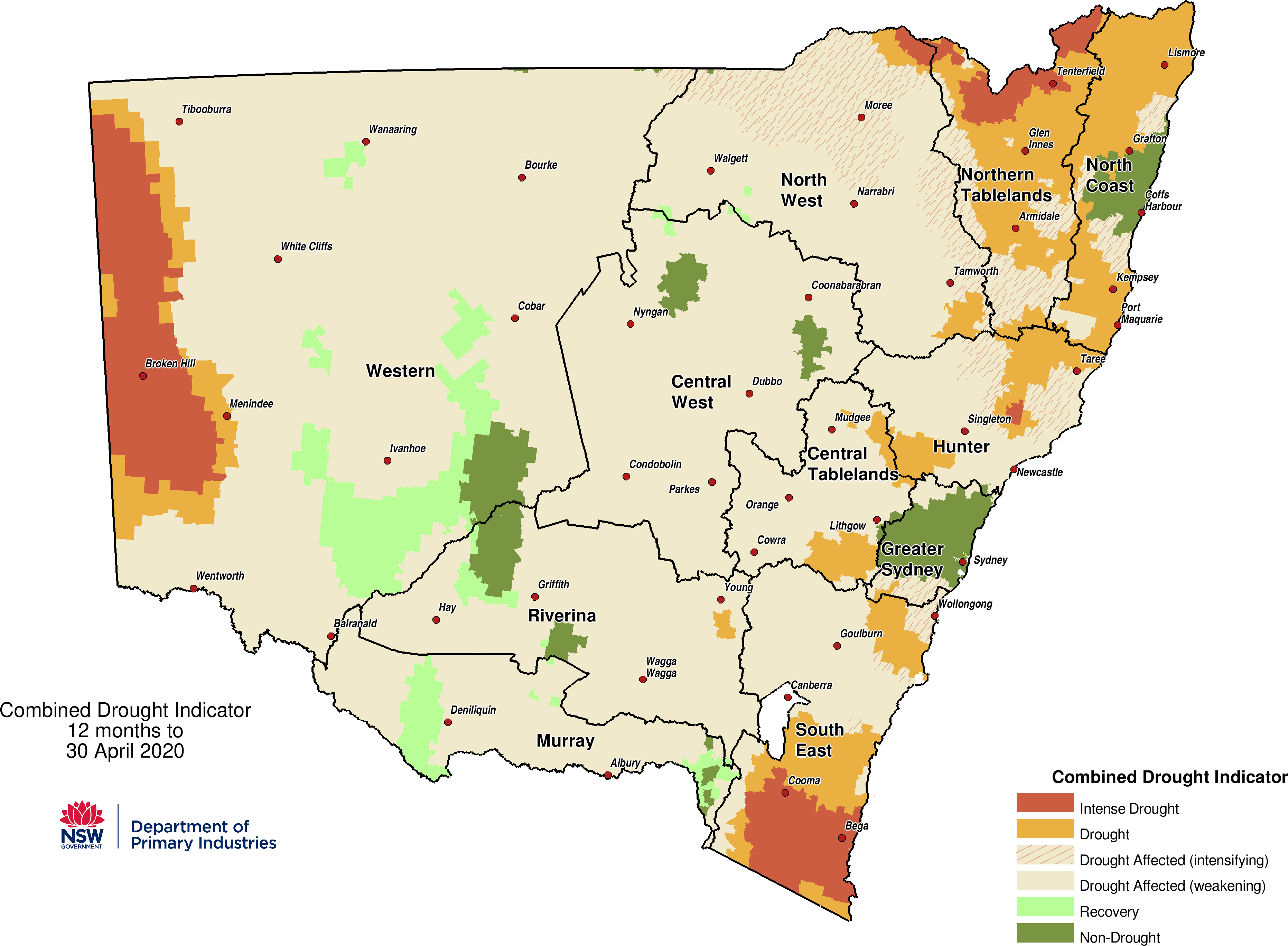
It is important to recognise the CDI provides an aggregated view of the State, and that on-ground conditions can be different to those displayed in the maps. They provide an ‘on average’ view of a particular region only. To report local conditions, use DPI Farm Tracker.
*Note: the presentation format of some maps has changed in this month's edition of the SSU. New systems for map production have been developed to operate under Covid-19 work arrangements.
Drought Duration
Drought duration is an important component of drought impact on farm businesses and communities. The drought duration map (Figure 2) shows the number of months since June 2017 that an area in NSW has been in one of the three CDI drought categories. The map shows that NSW continues to experience long-term drought conditions at 30 April 2020; The majority of NSW has experienced drought conditions for longer than 24 months.
*Note: The accumulated months reported are non-consecutive.
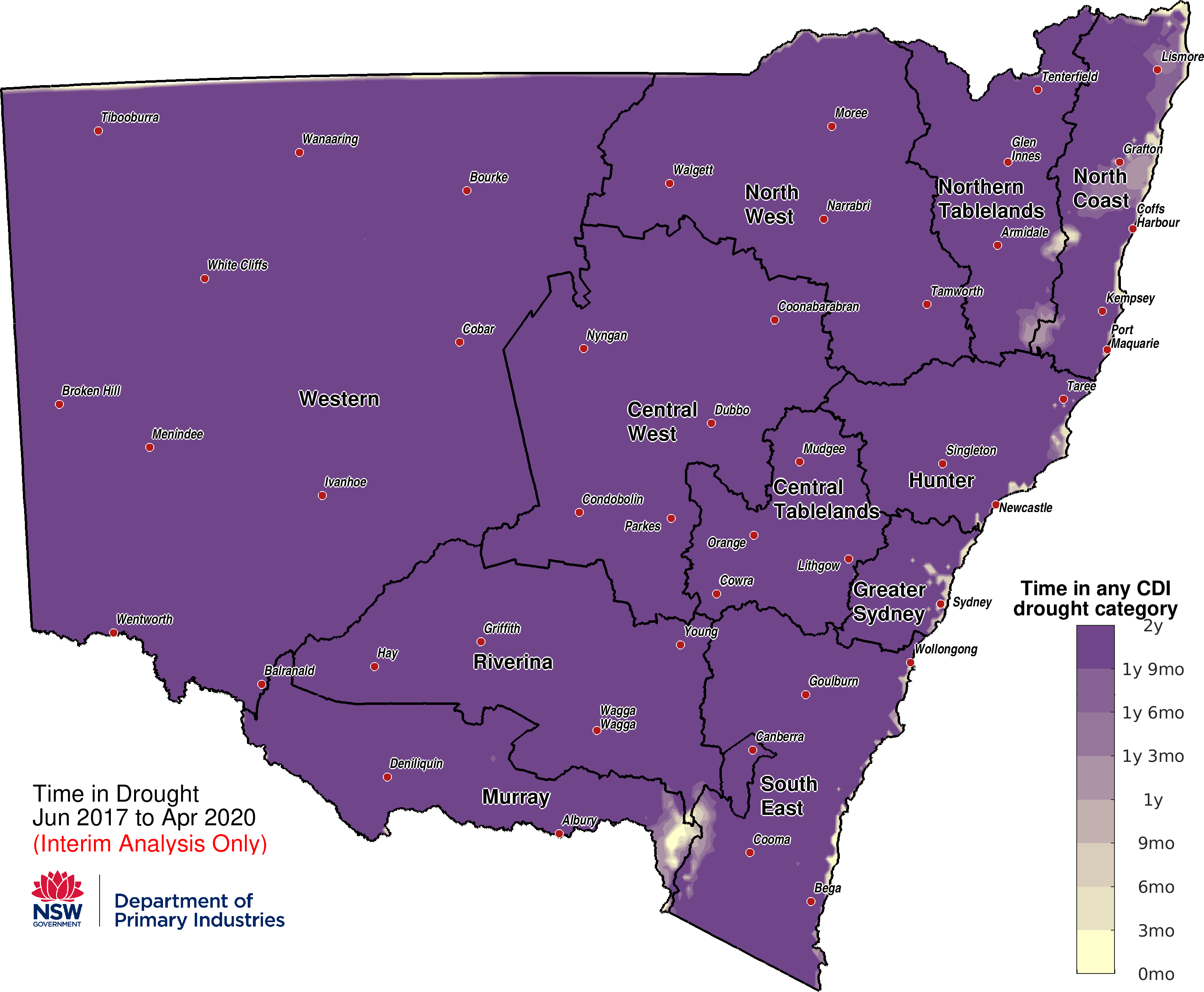
Rainfall
Much of NSW received greater than 50mm of rain in April (Figure 3a). Totals between 100 to 200mm were recorded in the Central West, Central Tablelands, Riverina, Murray and South East Local Land Services (LLS) regions. The Alpine region also experienced high rainfall totals where over 200mm was recorded in some areas. Less than 25mm was received in areas of the South East, Hunter, North Coast, North West, Northern Tablelands and Western LLS regions.
Rainfall accumulation for 2020 has been near or above average for most of NSW, however areas in the far west and south east of the state have remained drier than average. Higher totals have been received in many areas east of the Great Dividing Range (Figure 3b). Central areas of have received between 100-600mm, while totals further west range between 5-200mm for the year. Rainfall has positioned some regions well for recovery later in the year if follow-up rain is maintained.
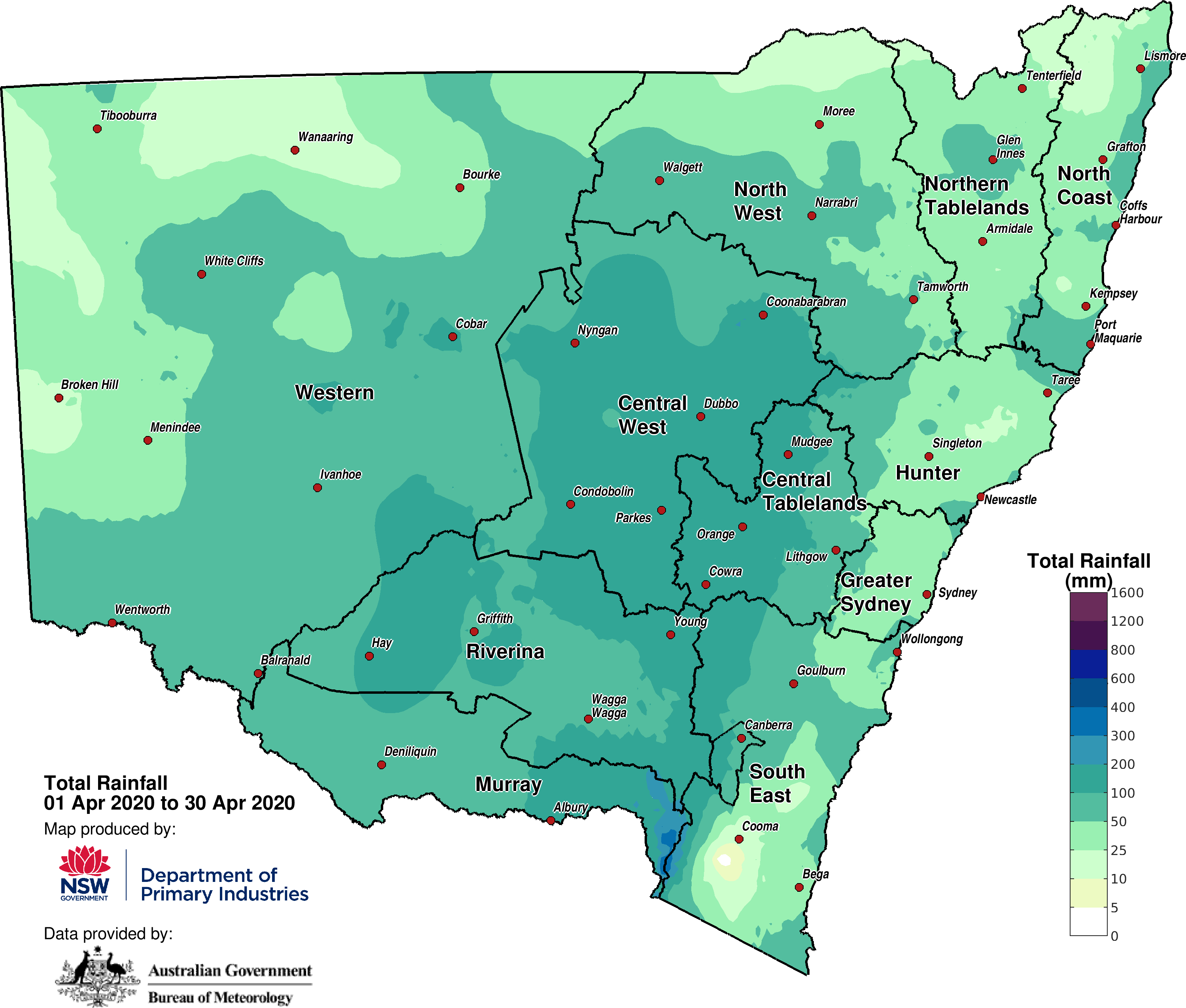
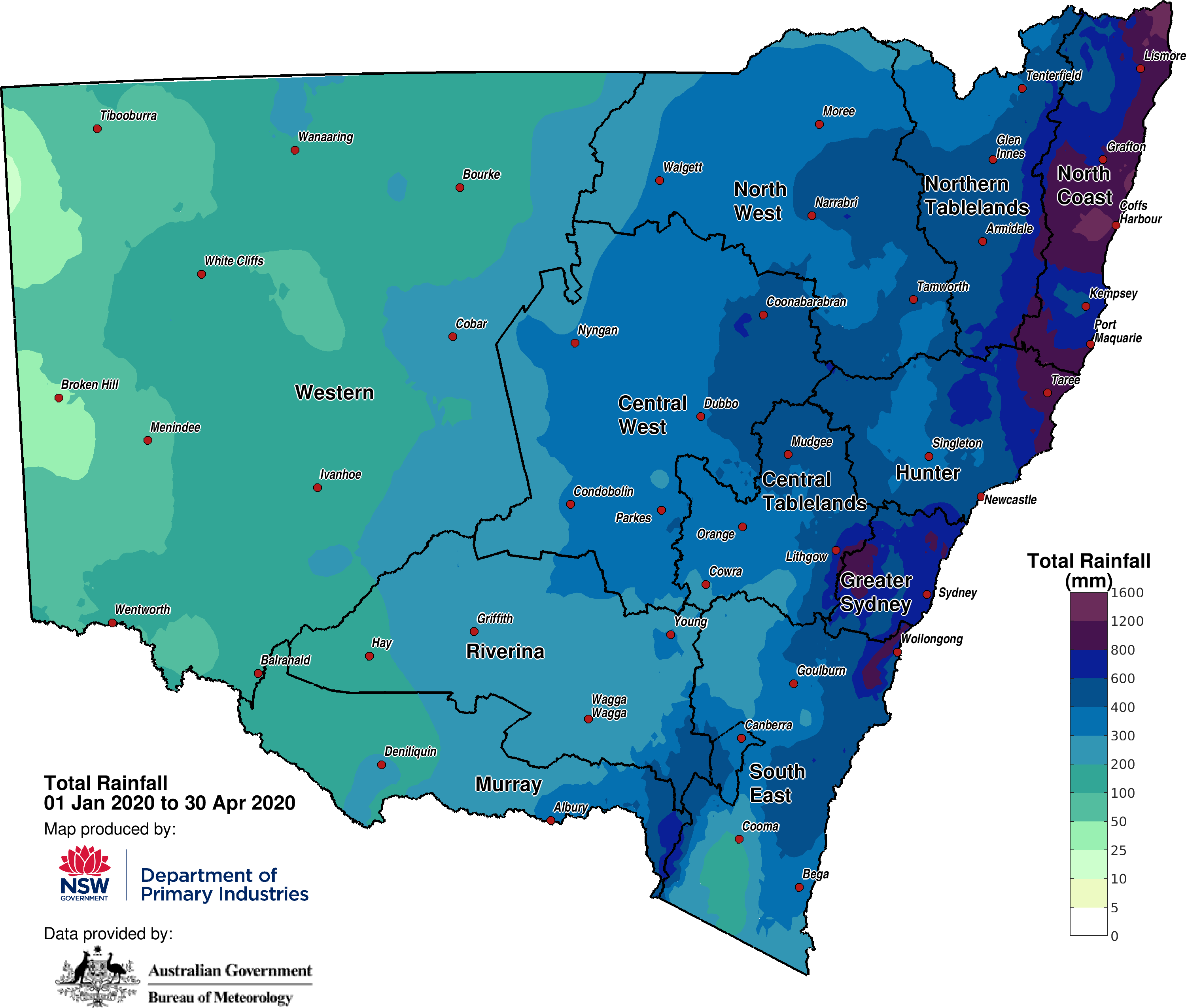
Temperature
The average April daytime temperatures (Figure 4) were above 21°C across most of NSW. Warmer temperatures, above 24°C were recorded in the north and west of the state. Cooler temperatures of 15-21°C were recorded across all tableland regions and the southern slopes of NSW. Temperatures above 6°C were recorded in parts of the Alpine region.
Overnight temperatures (Figure 5) were above 12°C for most of the coast and north-west areas of NSW. Elsewhere overnight temperatures ranged between 9-12°C but were cooler in most tablelands’ regions (between 3-12°C) and the alpine area where the range was 0-9°C.
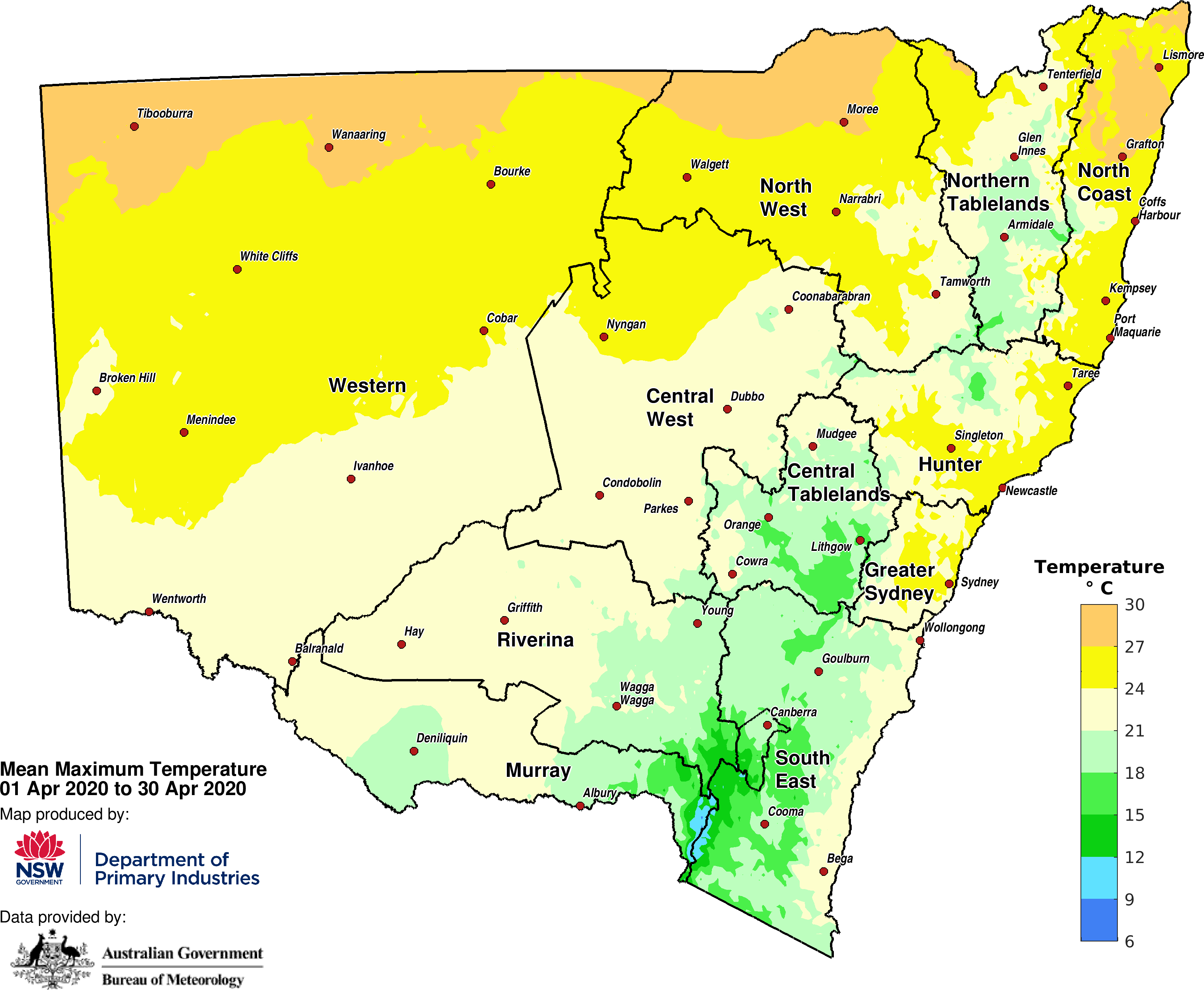
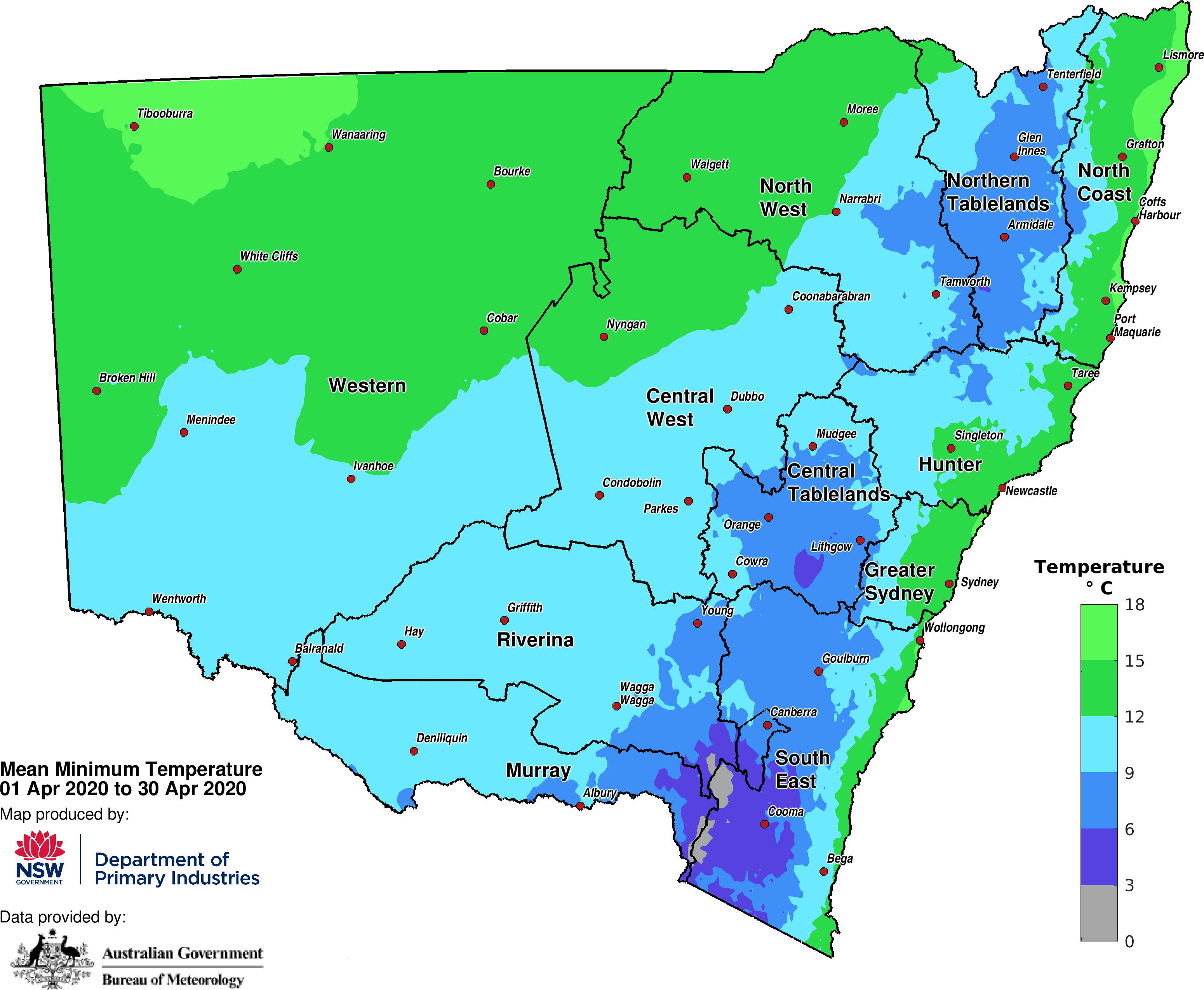
Normalised Difference Vegetation Index (NDVI) Anomaly
The inclusion of a new remote sensing analysis from a collaboration between NSW DPI and Geoscience Australia (Digital Earth Australia program) for NSW has continued this month. The interim (beta) product (Figure 6) is a seasonal overview of the Normalised Difference Vegetation Index (NDVI) and replaces the monthly product used in previous editions of the State Seasonal Update.
The new analysis includes fortnightly passes of the satellite to build a seasonal estimate of the NDVI anomaly. The current analysis is for the three months from February to April (April 18). It highlights significant variability in field conditions being experienced across NSW, but also indicates that plant greenness levels have improved since the March edition of the State Seasonal Update.
Plant greenness levels are closer to normal values for late summer/autumn across much of the state and are above normal in many central and eastern areas of NSW. The analysis indicates that drought conditions have weakened substantially in many areas of the state.
Despite this, there are regions that are still experiencing below normal levels of greenness for this time of year.
A number of technical factors need to be considered when considering the new analysis:
- It is based on the USGS Landsat satellite, quality-controlled and provided by Geoscience Australia's Digital Earth Australia program. This collects data at a 30m spatial resolution every two weeks, contrasting to the 1km resolution of the previous product.
- There is a processing lag in Landsat data that can be up to ~3-4 weeks, therefore the data for the last twelve days of April is not yet available.
- The visible and infrared bands are used to calculate NDVI, which then calculates vegetation greenness. This is a useful measure of vegetation density and plant health.
- Clouds and smoke can sometimes obstruct observations, causing gaps in the NDVI data or banding in the available imagery. As seen in the Figure 6a, smoke and clouds obscured much of the southeast over the last 3 months, resulting in missing data.
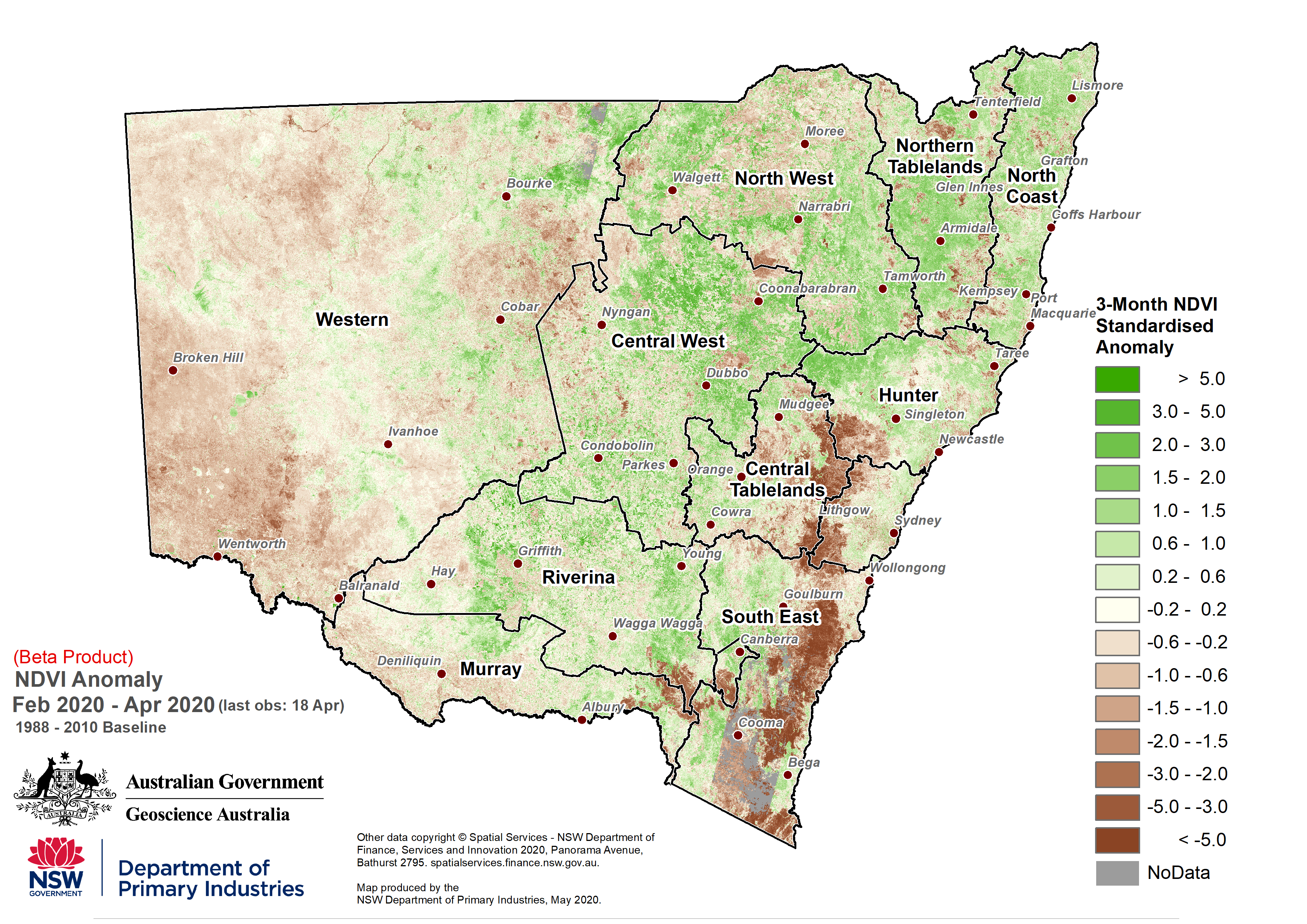
NSW Farm Dam Survey
Rainfall in March and April has improved farm dam levels in many central and north-west areas of NSW (Figure 7). Areas in eastern NSW have slightly improved dam levels compared to those reported in the March edition of the State Seasonal Update. There are large areas in the south and far western regions showing very low farm dam levels.
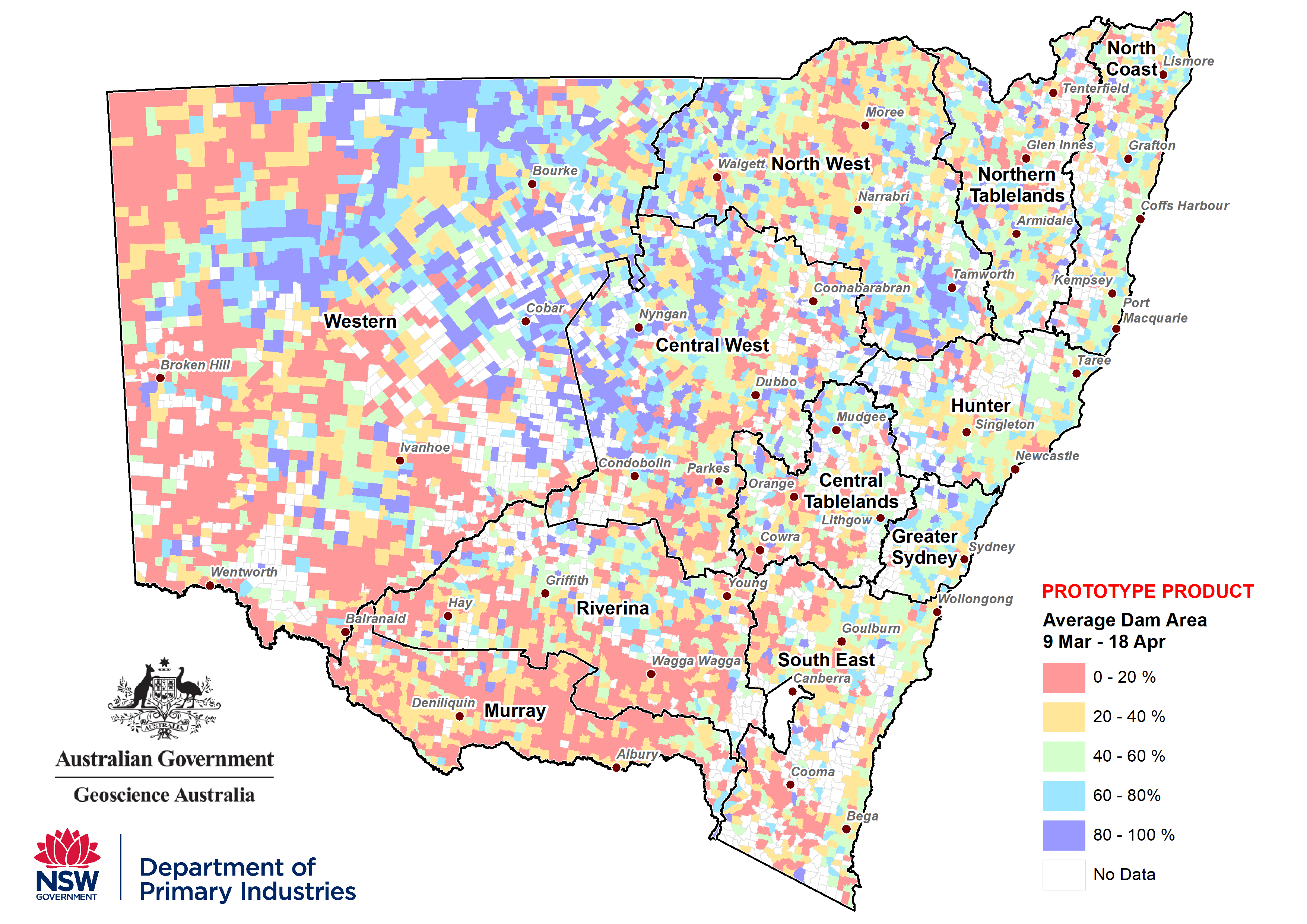
Short-term Soil Water and Plant Growth
The short-term response of soil water and accumulated pasture growth to the recent rainfall are shown in Figure 8a and Figure 8b. The average soil water recharge over the past 30 days show that central and eastern areas of the state are responding strongly to recent rainfall. This has also aided the accumulated pasture growth over the last 30 days in these regions.
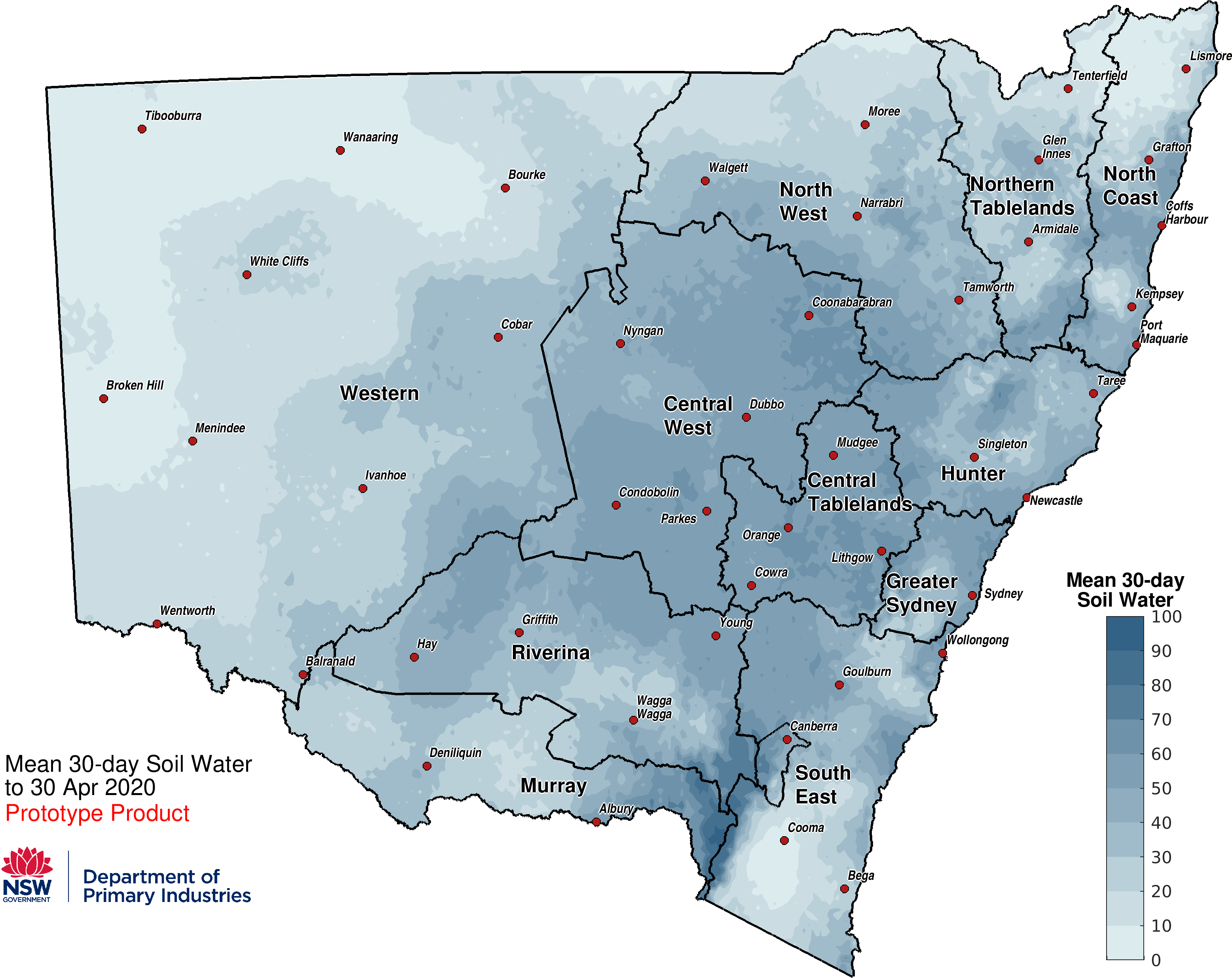
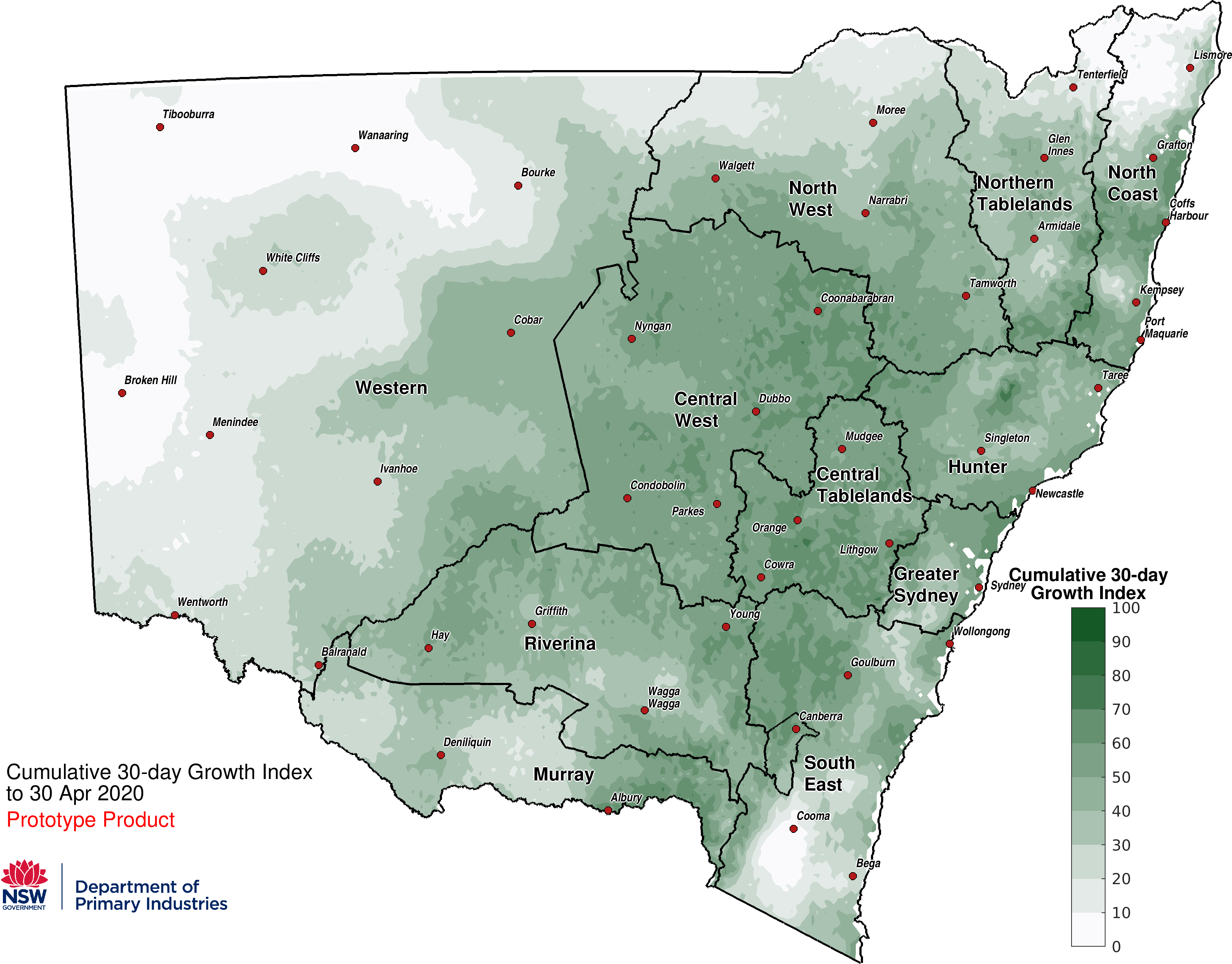
Soil Water Index
The Soil Water Index (SWI, Figure 9) remains below average across most of NSW. There has been an improvement since the March 2020 State Seasonal Update, with a large region of NSW transitioning out of the extremely low category. Rainfall accumulation during 2020 has helped improve the soil water index in many regions.
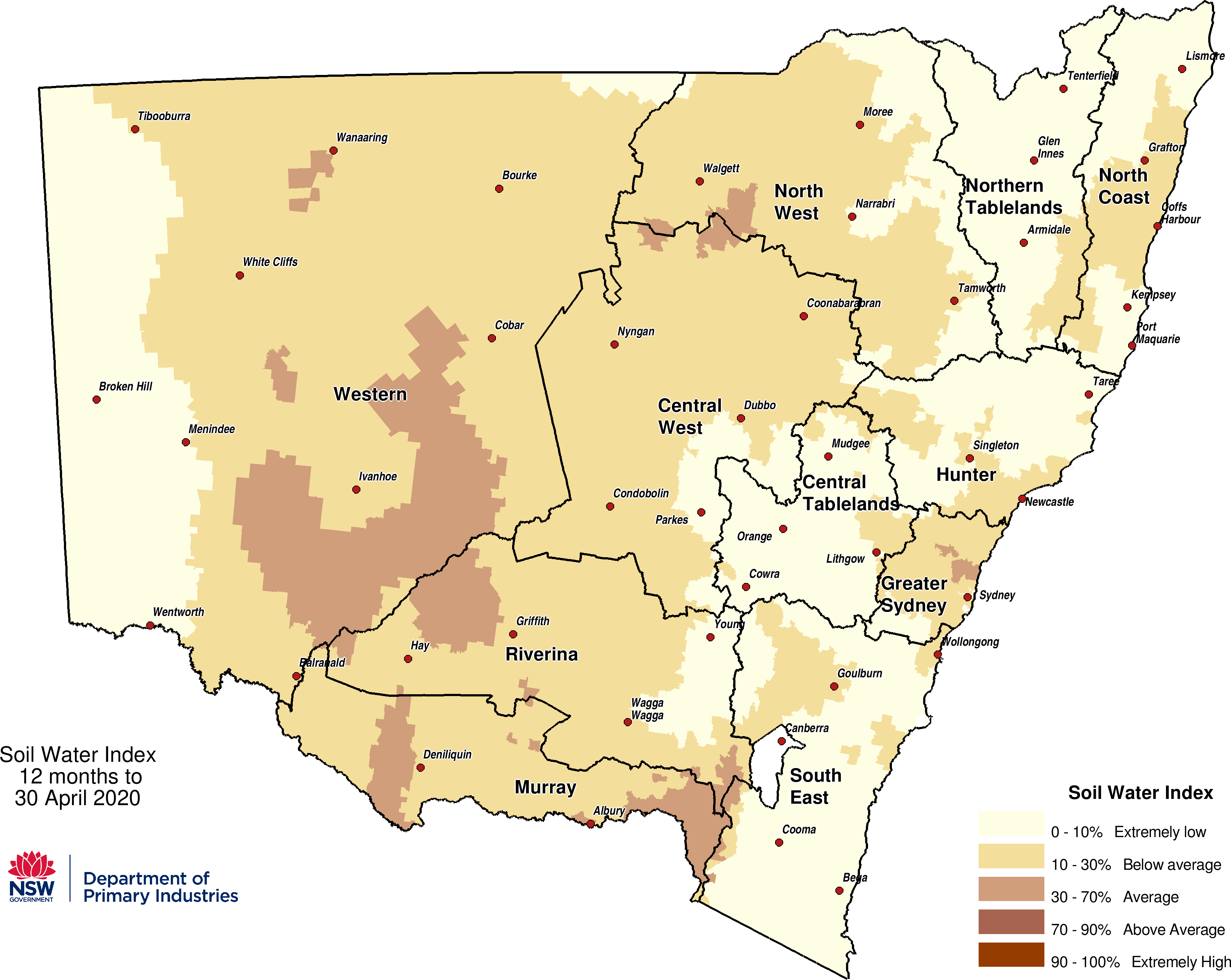
Plant Growth Index
The Plant Growth Index (PGI, Figure 10) remains below average to extremely low across large areas of NSW at the end of April. There has been a reduction in the area of the state in the extremely low category and an increase in the area now in the average category since the end of March.
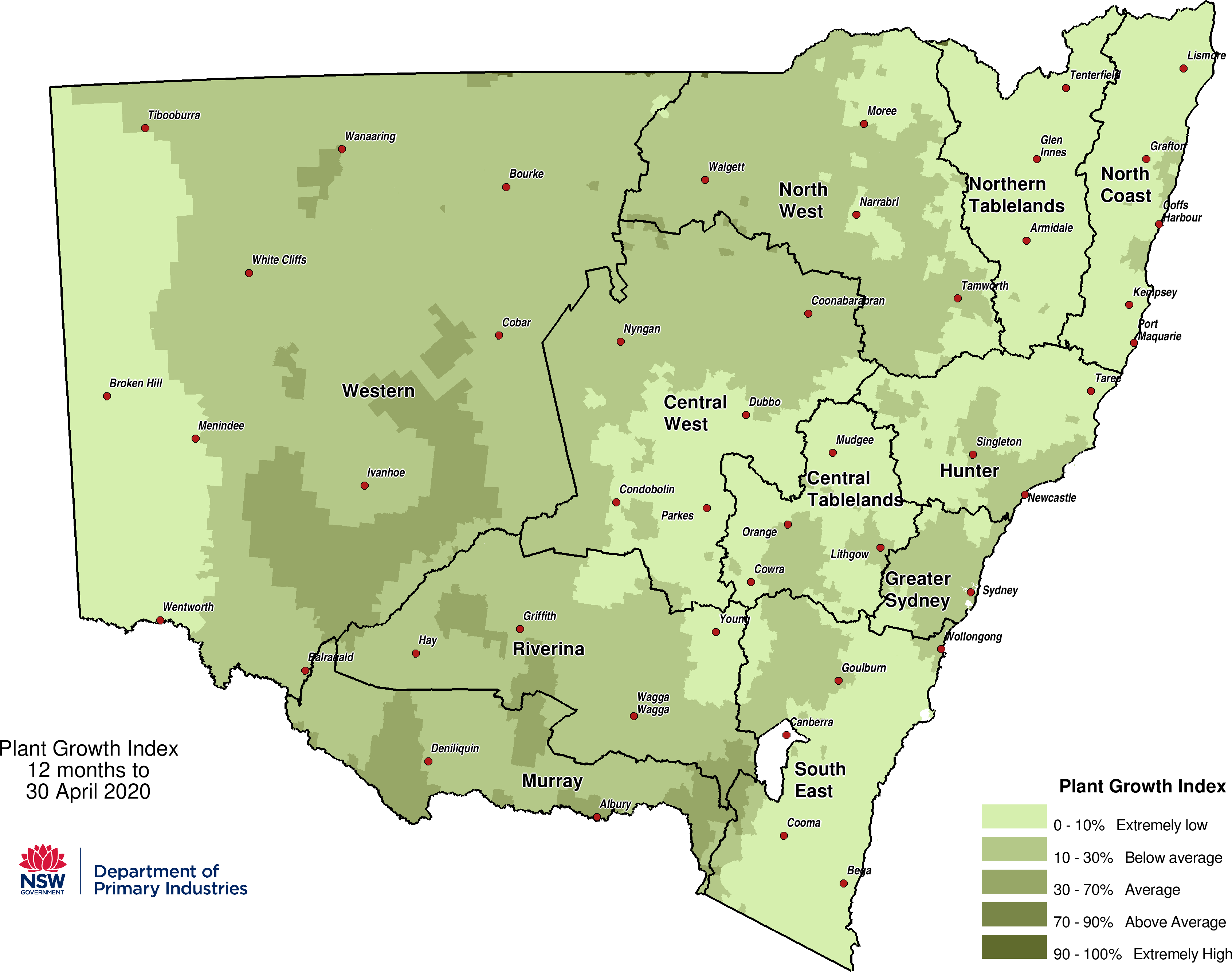
Rainfall Index
Rainfall accumulation during 2020 is beginning to improve the Rainfall Index (RI, Figure 11) across large areas of NSW. Despite most of the state still tracking below average, there was a large reduction in the area that was extremely low at the end of April. Rainfall totals in many areas have been enough, relative to average, to begin rebuilding long-term rainfall deficits.
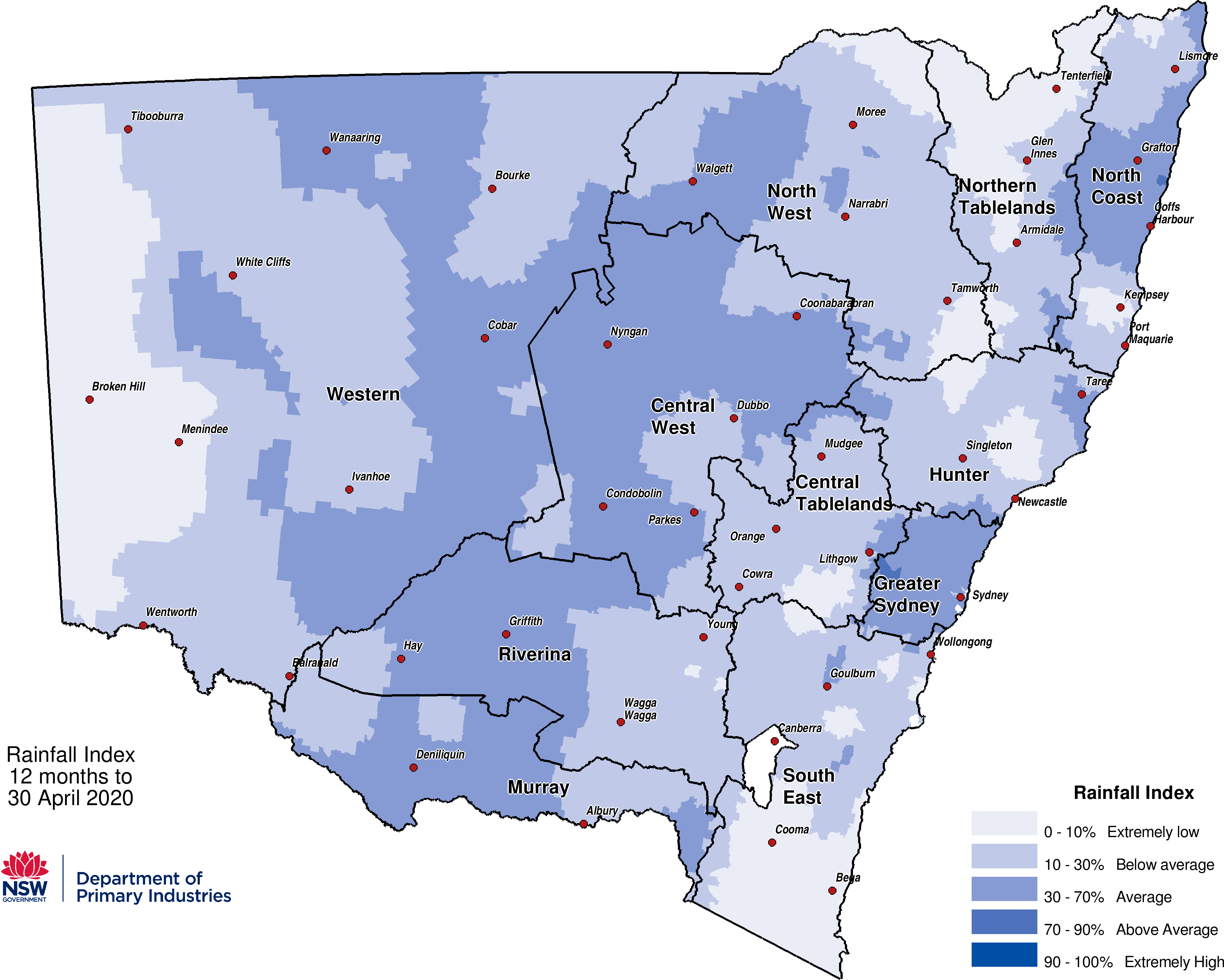
Drought Direction Index
The Drought Direction Index (DDI, Figure 12) indicates that central and some western areas are displaying a strong wetting trend at the end of April. The trend is neutral to weakly drying in some coastal areas and in parts of the north-east, while a strong drying trend is indicated in parts of the Northern Tablelands and North Coast.
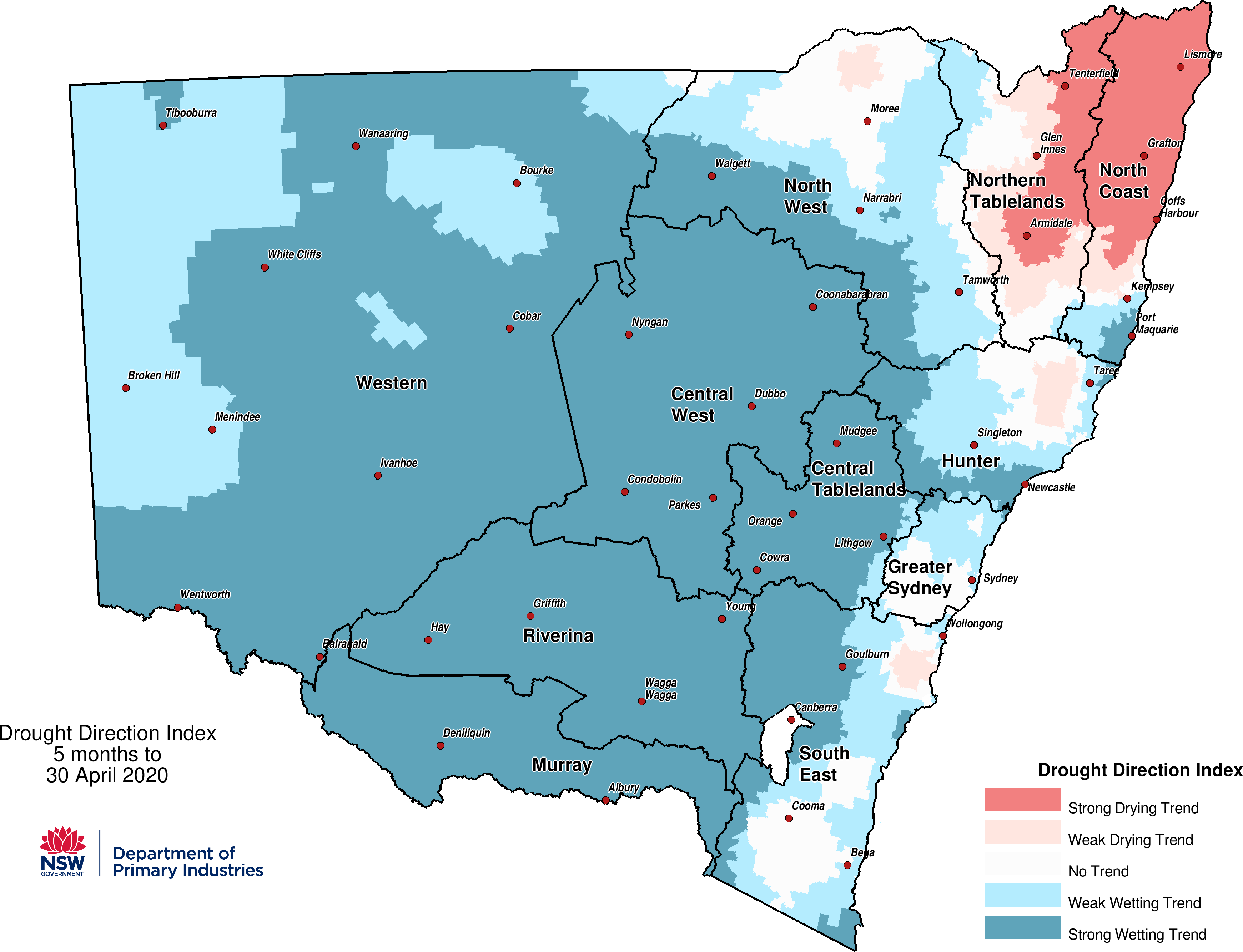
Changes in the individual drought indicators may have occurred since this update was released. For the most current information, please visit DroughtHub.
CDI status for the regions
Figure 13 displays the CDI status for each individual Local Land Services regions to 30 April 2020. The regional descriptions are based on data available until the end of April 2020.
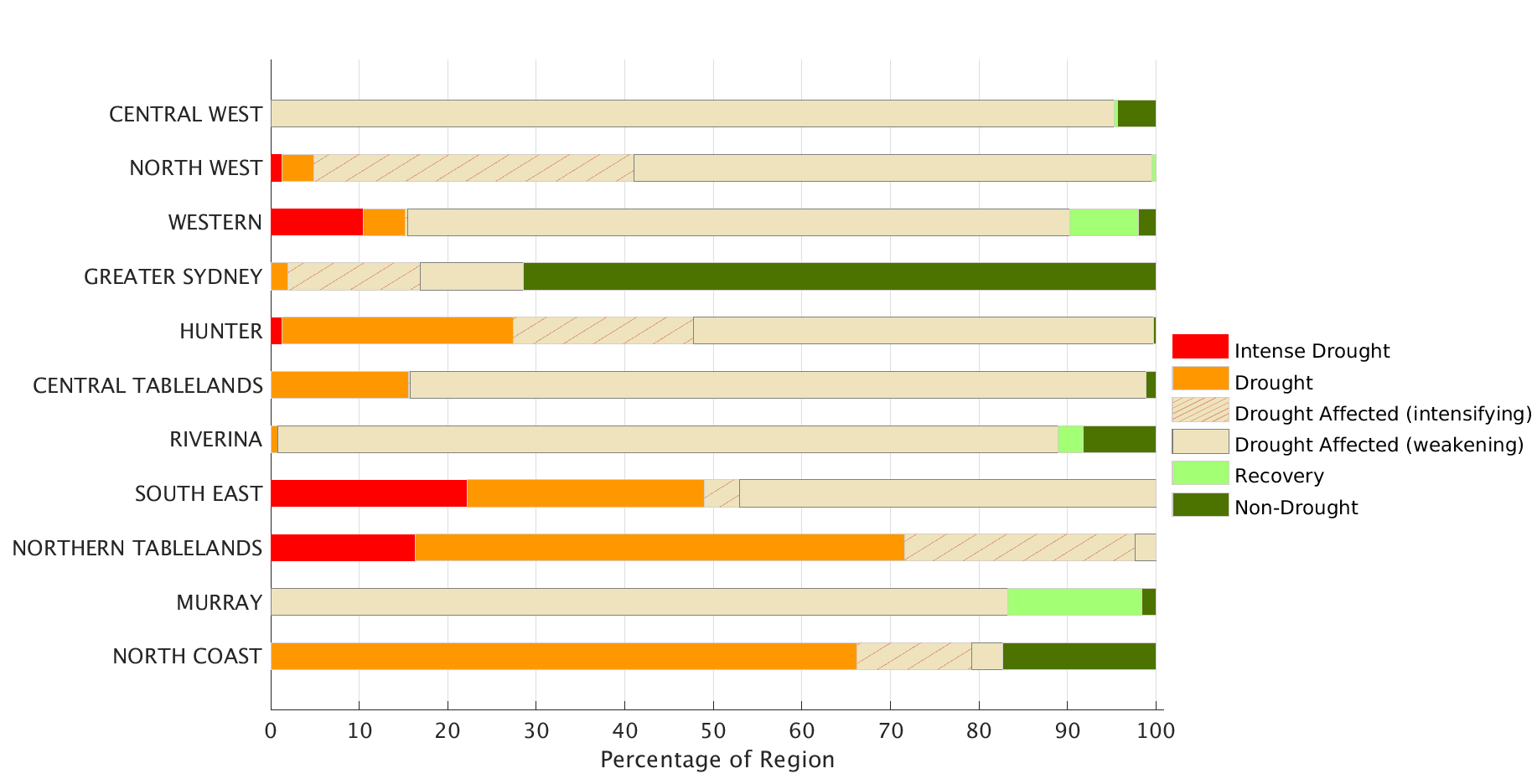
Murray and Riverina regions
Rainfall during April has improved conditions across the Murray and Riverina Local Land Services (LLS) regions. The Combined Drought Indicator (CDI) shows most of the region is still in one of the three CDI drought categories (Figure 14), however there has been a general transition out of the more severe CDI categories since January. The April rainfall has been ideal for winter crop planting activities and has generated a flush of pasture growth prior to the winter feed gap.
The seasonal NDVI anomaly data (Figure 15) has shown large improvements since the March State Seasonal Update. Much of the region is experiencing normal to higher than normal plant greenness for the February to April period. The impact of the recent bush fires is still evident south of Tumut.
The time series charts (Figure 16) shows the individual response of the drought indices for Hay, Finley and Temora. Despite the recent improvements to the indices, follow-up rain is still needed to continue these improvements. The NDVI data is suggesting that the rainfall has been effective and improved on-ground conditions, however most of the indices have plateaued since March highlighting the importance of follow-up rain to aid longer-term improvement.
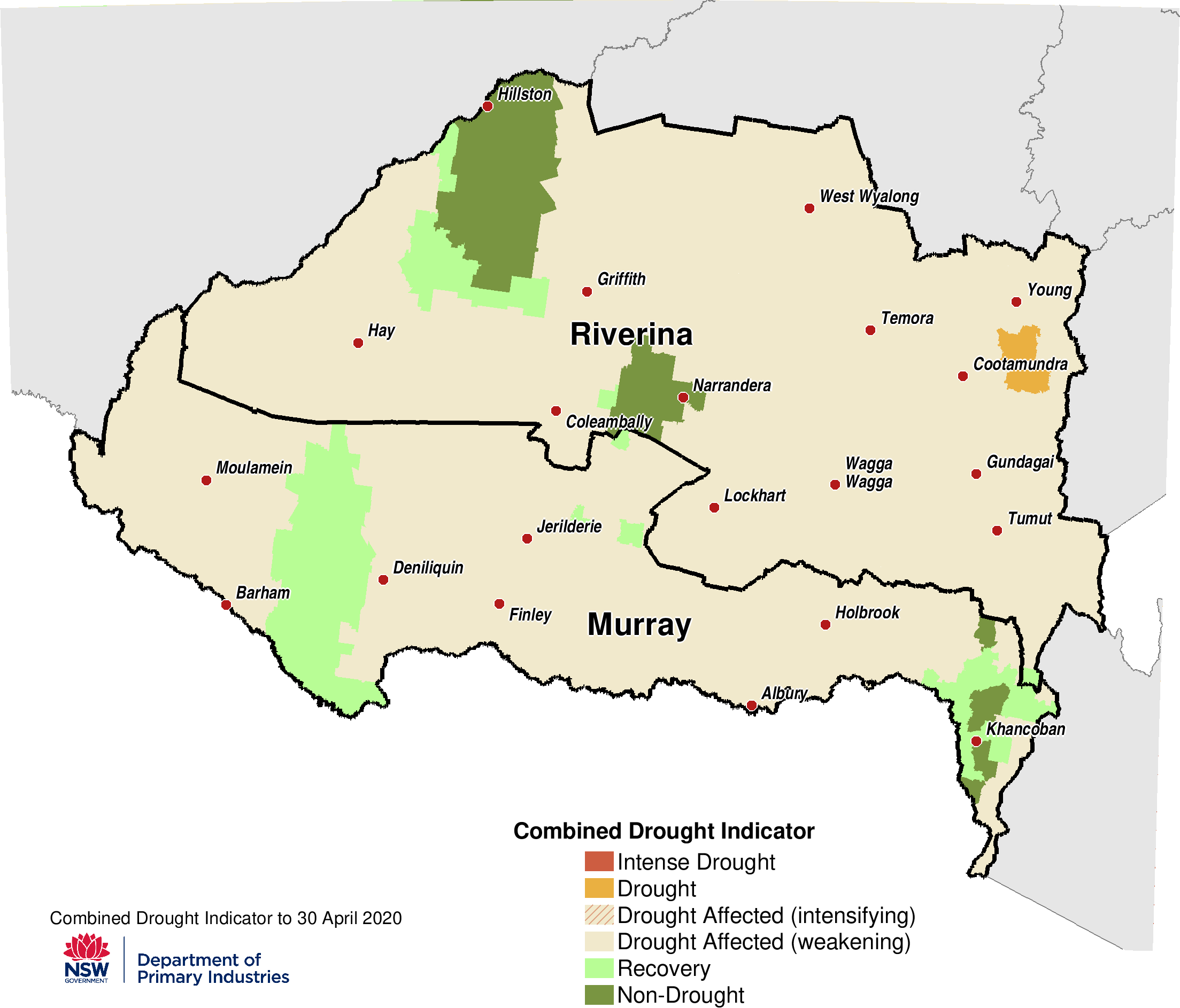
![]()
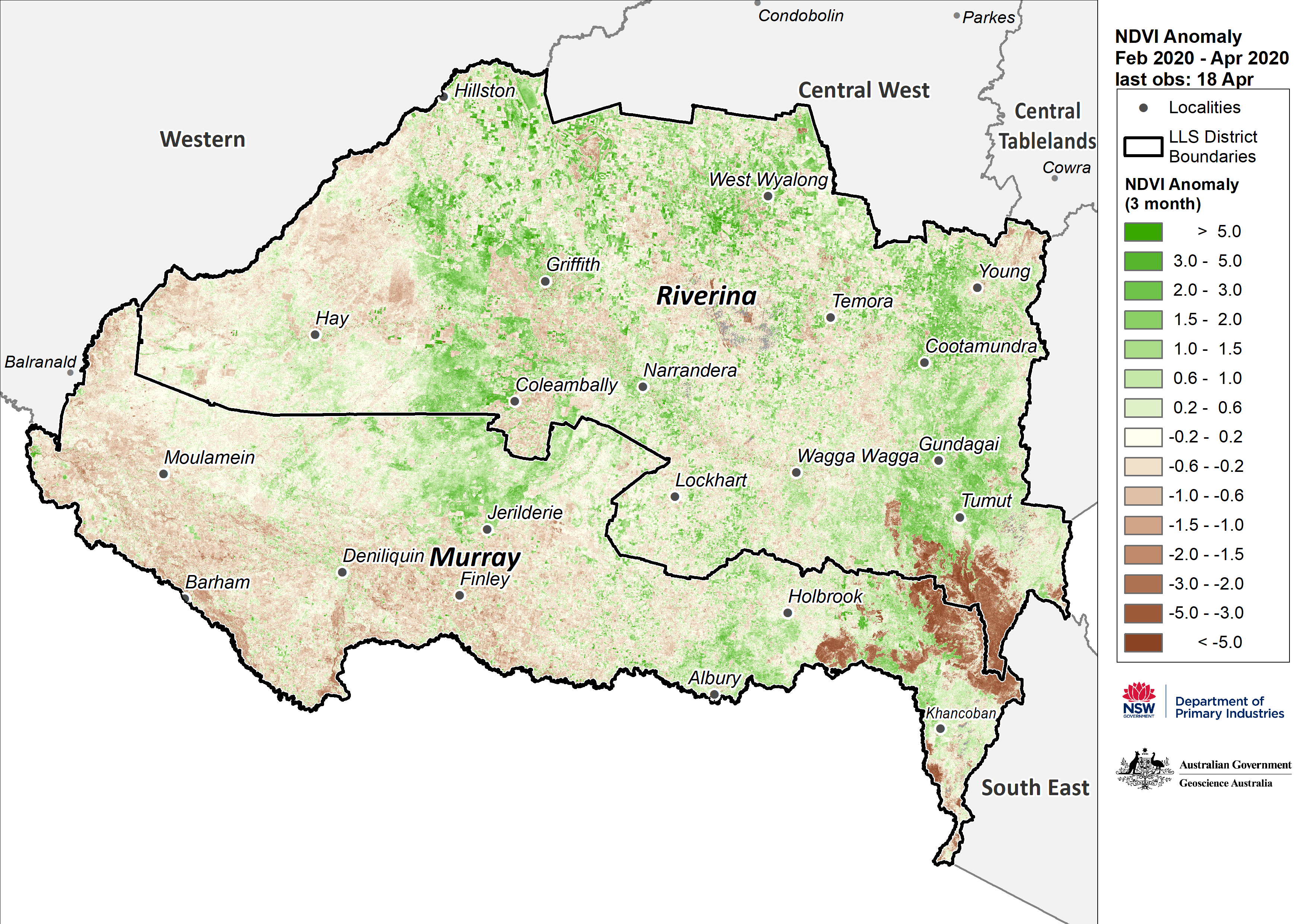
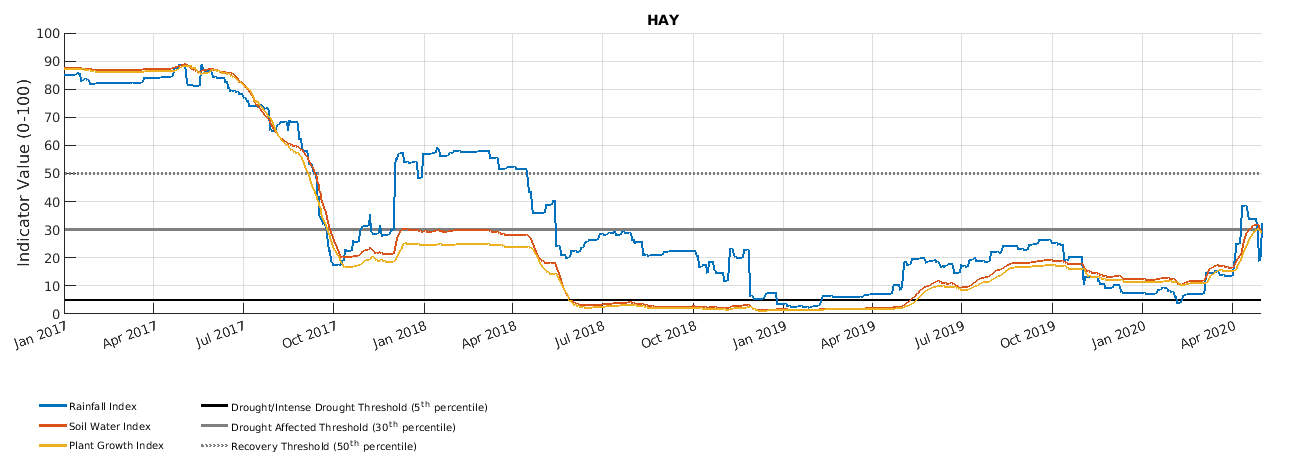
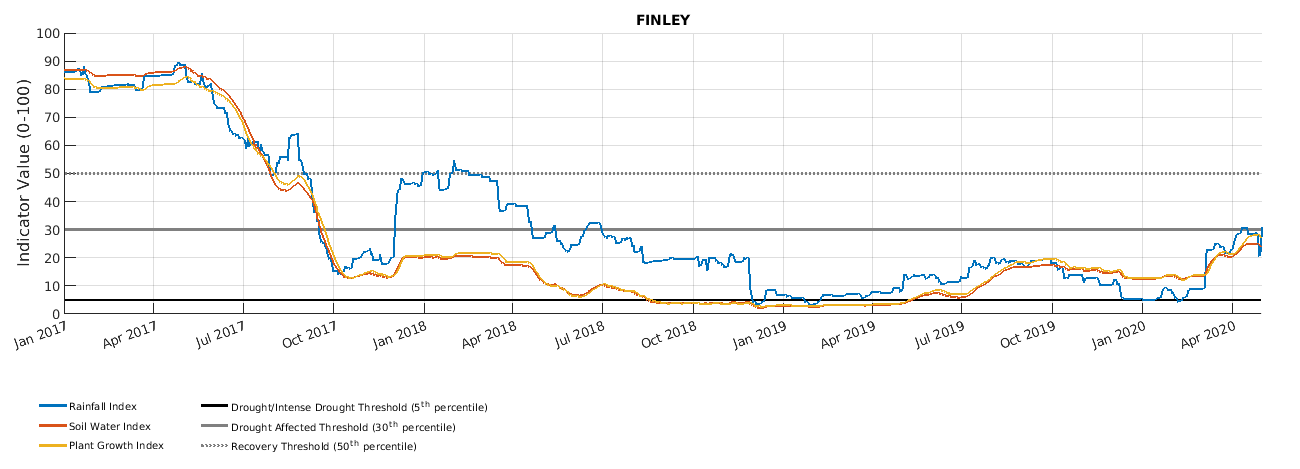
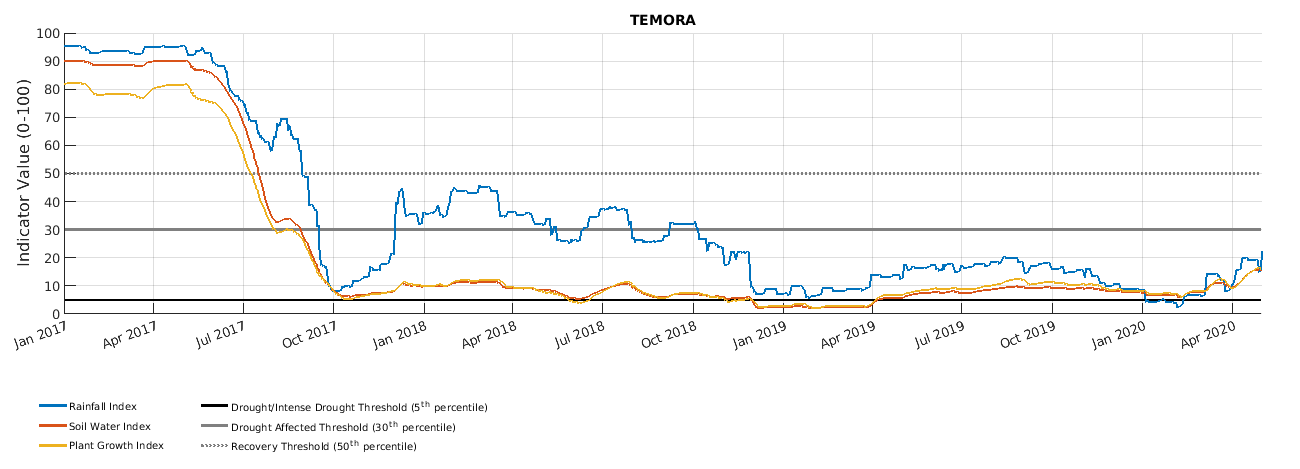
Western region
Rainfall during March and April has improved conditions in many parts of the Western Local Land Services region (LLS), however there is still a large degree of variability. The Combined Drought Indicator (CDI) shows that most of the region is still in one of the CDI drought categories, though there has been a transition from the Drought Affected to Recovery and Non-drought categories (Figure 17) in some areas.
The drought has weakened in some areas of the Western LLS region over recent months and are currently well placed for the continuation of improved conditions if consistent follow-up rain is received. Despite this, there are still large areas in the region that have not yet had relief, particularly further west. These areas require an effective rainfall event to initiate a weakening of drought conditions.
The seasonal NDVI anomaly data (Figure 18) shows a range of plant greenness levels compared to the long-term expectations for the February to April period. Plant greenness is generally better than normal in the east and near normal in central and north-western parts of the region. The west and southern areas are showing lower than normal greenness and there is also an area in the east between Cobar and Bourke where plant greenness levels are lower than normal for this time of year. The data tracks the high degree of variability in field conditions across the region, with considerable differences between sub-regions and in some cases farm-to-farm.
The time series charts (Figure 19) show the individual response of the drought indices for Bourke, Ivanhoe, and Wentworth. Bourke and Ivanhoe have experienced a recent improvement compared to Wentworth, however follow-up rainfall is needed to continue these improvements. There is an example of a false early-stage recovery at Ivanhoe in April and May 2019. This highlights the importance of follow-up rainfall for sustaining the potential of longer-term drought recovery. Wentworth has remained comparatively dry in 2020 and there has been no relief to drought conditions.
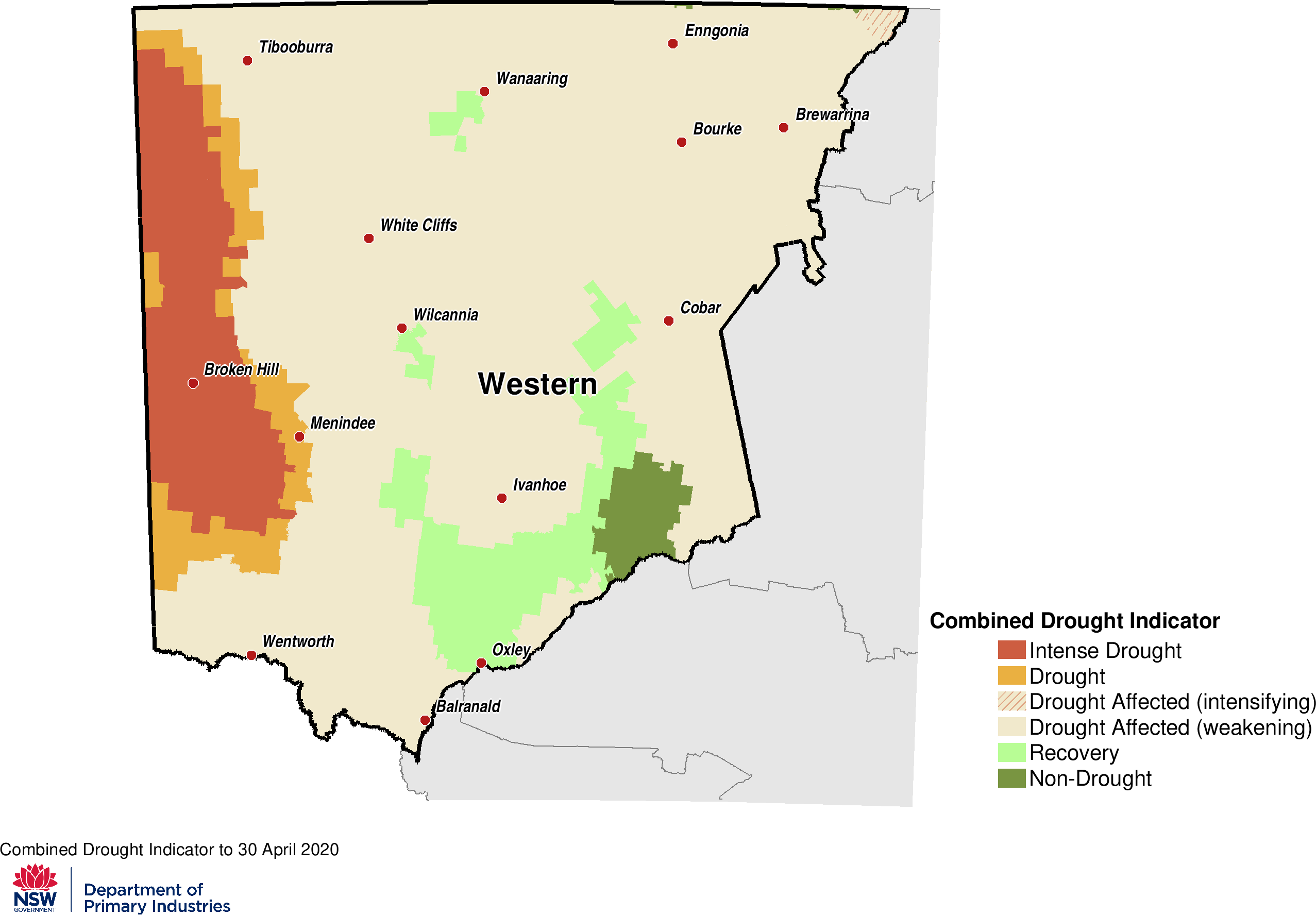
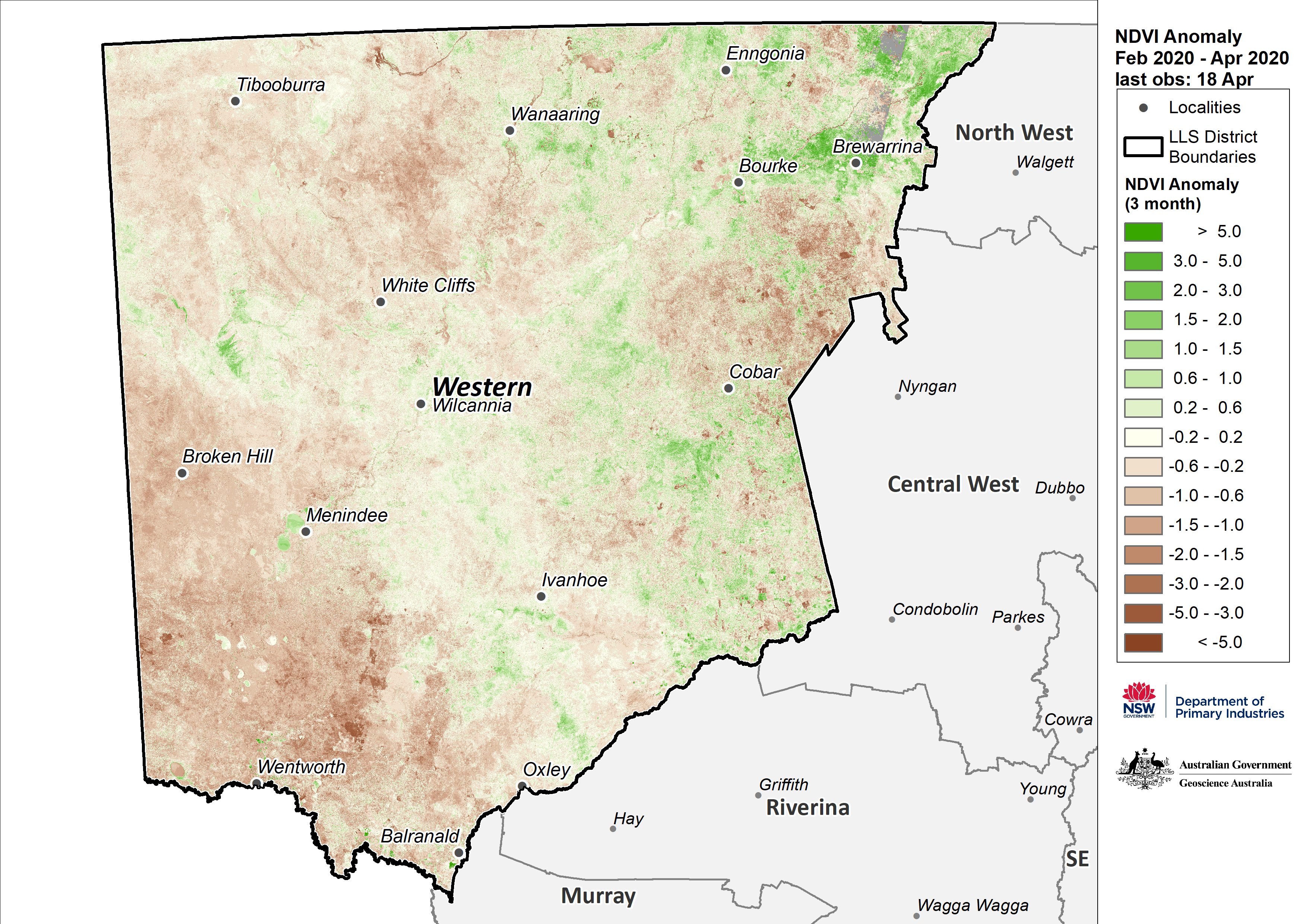

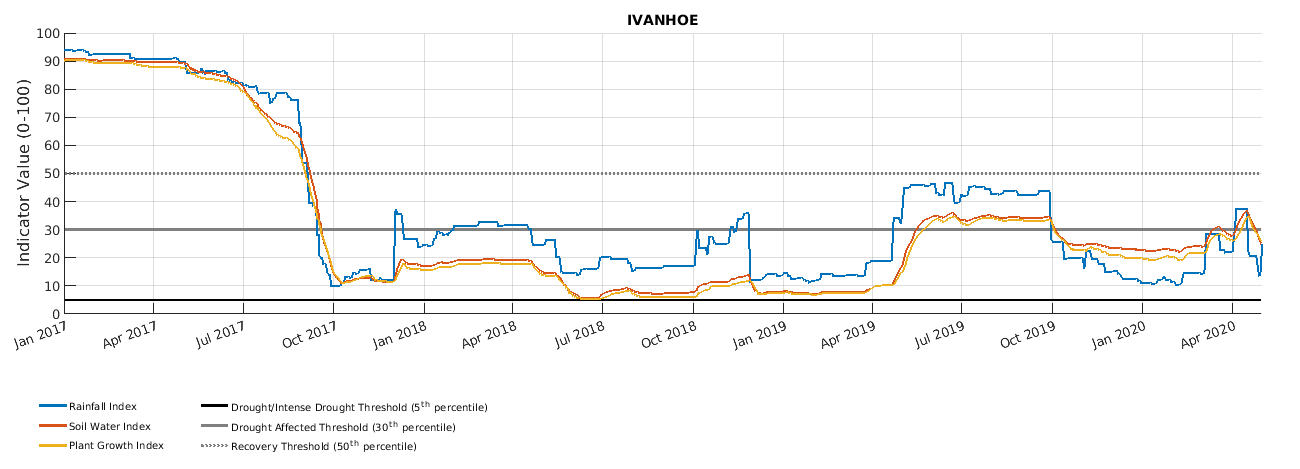
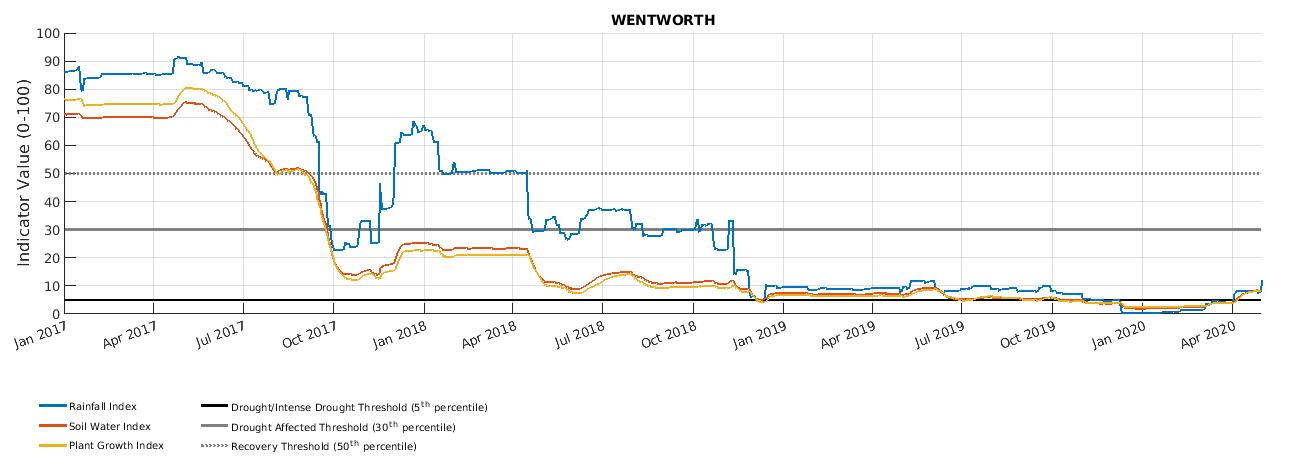
North West, Northern Tablelands and North Coast regions
Despite rain during 2020, the majority of the North West, Northern Tablelands and North Coast Local Land Services (LLS) regions continue to be in one of the three Combined Drought Indicator (CDI) drought categories (Figure 20). The area in Non-Drought remains similar to that reported in the March State Seasonal Update, while the area in Intense Drought declined. There is some concern that the drought event is re-intensifying in some areas over the past month. Follow up rainfall is needed to sustain on-ground improvements in these areas.
While the CDI shows varying levels of drought intensity across these regions, there has been a general improvement to plant greenness levels during the February to April period. The seasonal NDVI anomaly data (Figure 21) shows a substantial improvement since the end of March. This indicates that while the recent rainfall has improved pasture condition on the ground over the last two months, this has not been substantial enough to change the longer-term deficit in conditions tracked by the CDI. The drought indicators examine the last twelve months relative to what is expected in the region at this time of year. To alleviate the long term deficits further rainfall will be needed during winter to recharge soil water levels so that optimal growth can occur during Spring.
The time series charts (Figure 22) showing the individual response of the drought indices for Moree, Walgett and Tenterfield reflect the long-term trend of the drought indices tracking in the bottom 5th percentile of the historic range. Despite the recent rain, the improvement to the indices are modest and plateaued quickly at the end of March. The time series chart for Lismore illustrates an example of a region that has recently transitioned out of drought into the Recovery CDI category and then quickly reverted back to the Drought Affected category. Comparing the time series, the drought event at Lismore has been shorter and less intense than the other locations at Walgett, Moree and Tenterfield. This initially led to a faster recovery from drought but also highlights the importance of follow-up rainfall despite the high amount of rain received earlier in the year around Lismore.
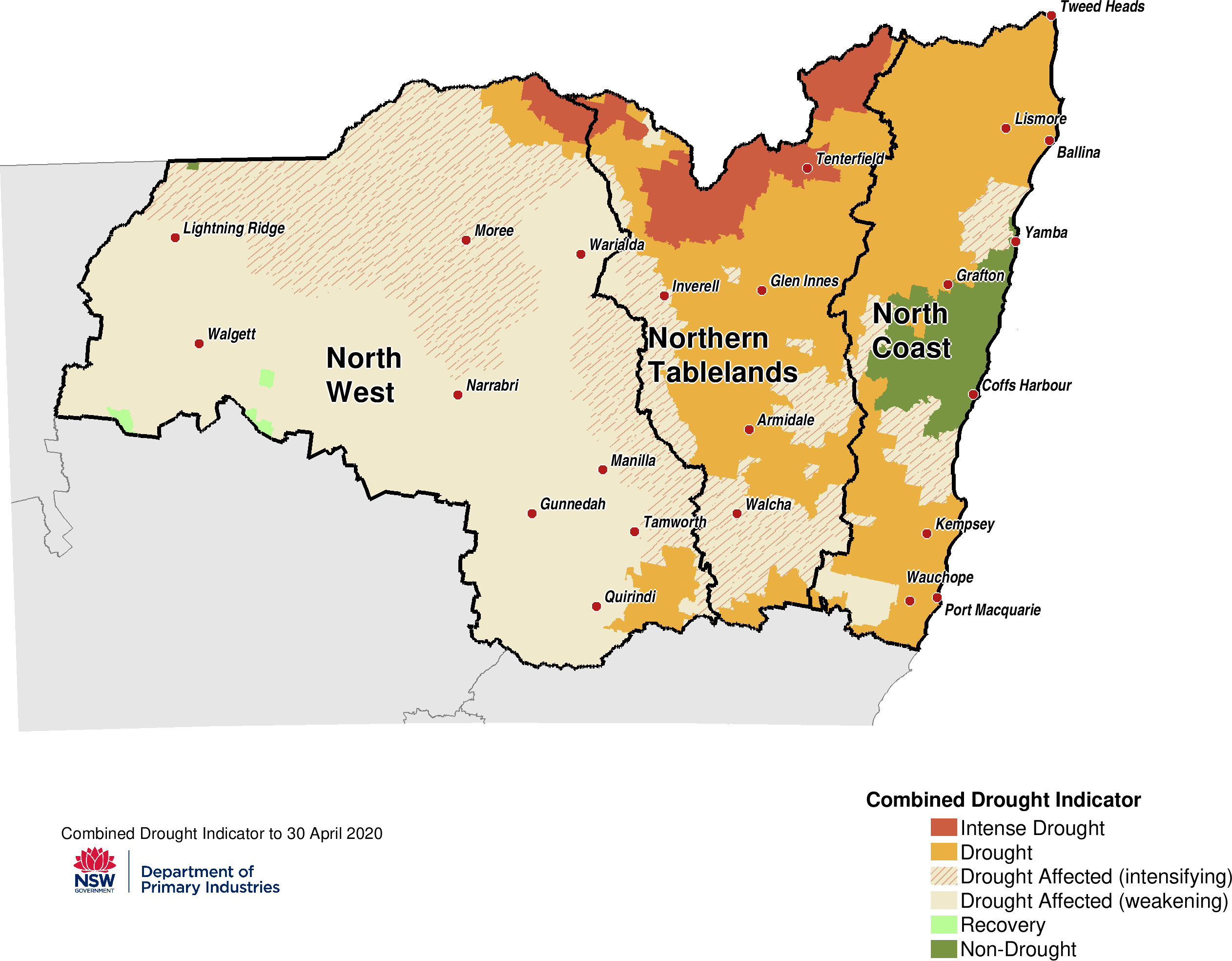
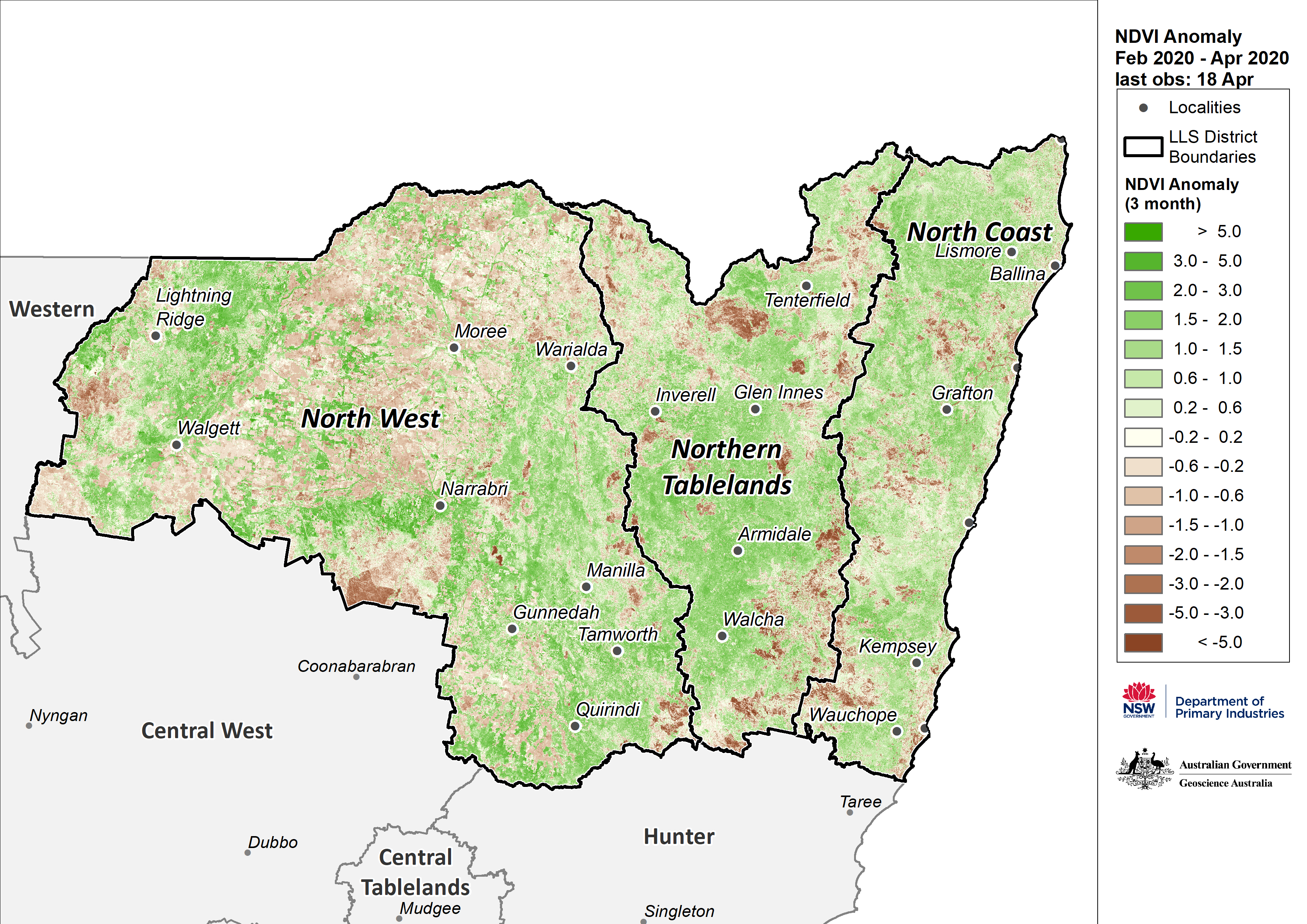
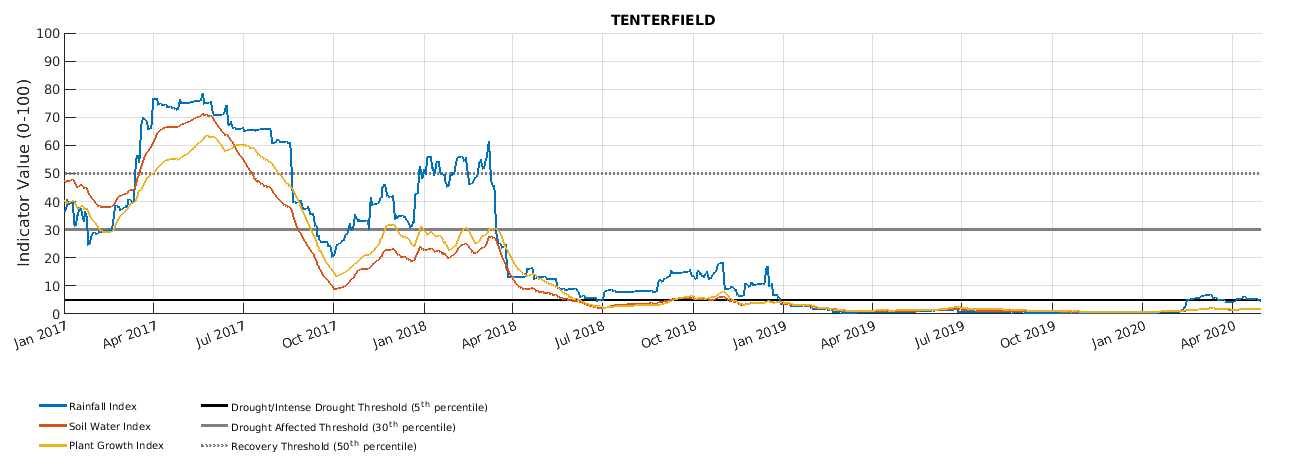
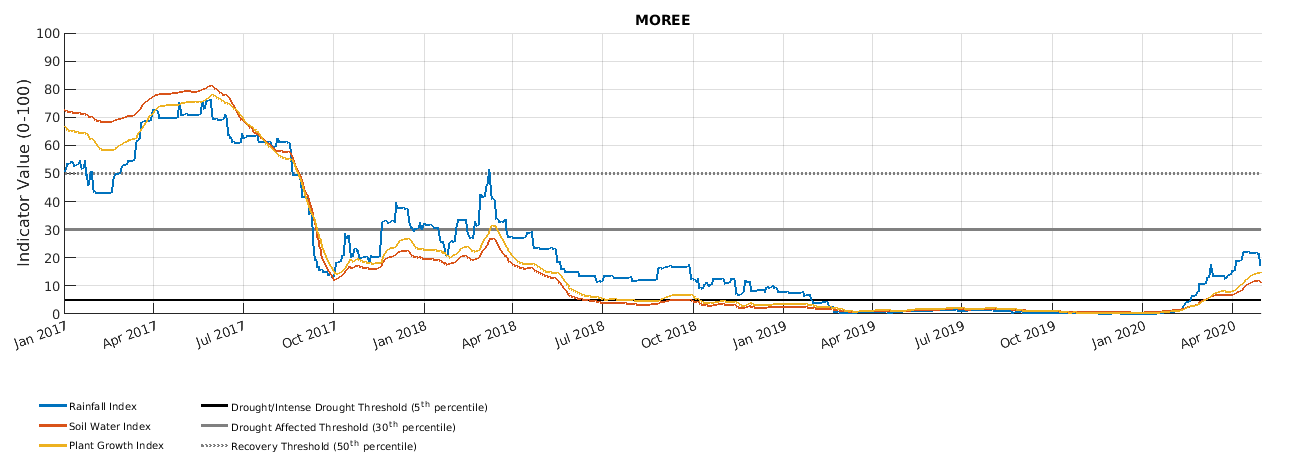
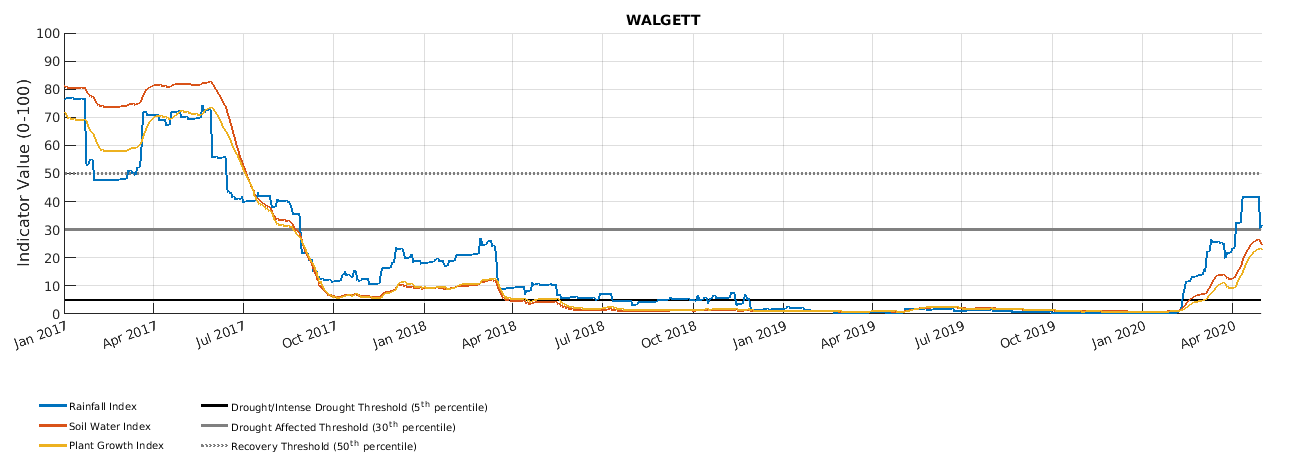
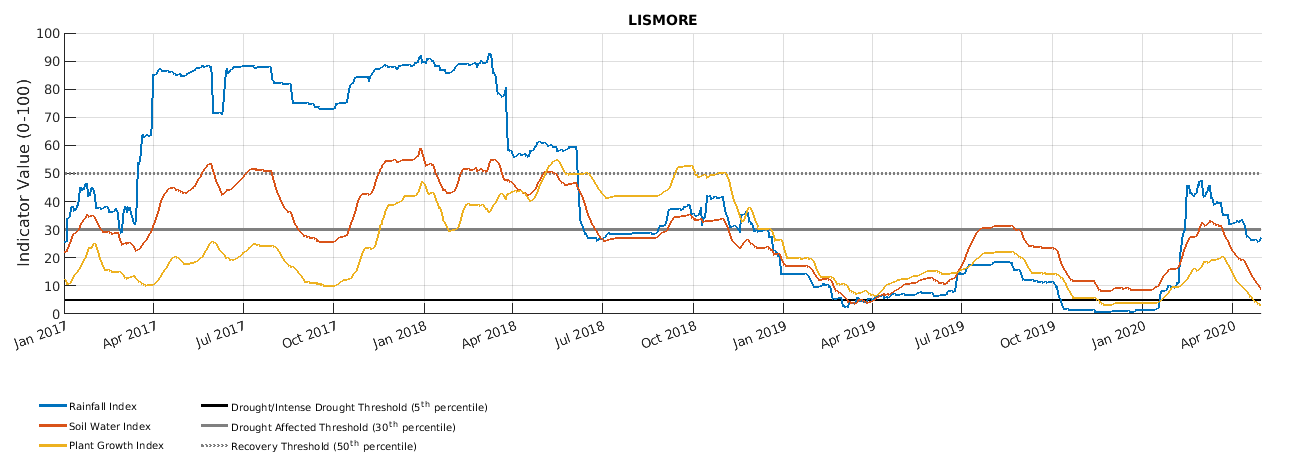
Central Tablelands, Central West, Hunter and Greater Sydney regions
Rain has weakened drought conditions substantially in many areas of the Central Tablelands, Central West, Hunter and Greater Sydney Local Land Services (LLS) regions. While most of the regions are still categorised in one of the three Combined Drought Indicator (CDI) drought categories (Figure 23), there has been a large reduction in the area categorised in Drought during April. Many of the Drought Affected areas are experiencing a transition towards a potential drought recovery and are well placed if follow-up rainfall is received during the winter. The 2020 rainfall accumulation has been more effective in the Greater Sydney region with most of the region remaining in the Non-drought category for a third consecutive month.
The seasonal NDVI anomaly data (Figure 24) shows a large improvement in plant greenness levels since March. Large areas across these regions are now showing normal to above normal levels of plant greenness for the February to April period. Despite this, the remote sensing data is still showing variability, with the far north-west and some tablelands regions still below normal levels for the period. The bushfire impact also remains evident in parts of the tablelands.
The time series charts (Figure 25) show the individual response of the drought indices for Cowra, Condobolin and Singleton. Drought conditions have impacted the region for an extended period, where the soil moisture and plant growth indices have struggled to surpass the lowest 10th percentile of the long-term data. The recent rain has improved the indicators, though further rain is required to sustain longer-term improvement.
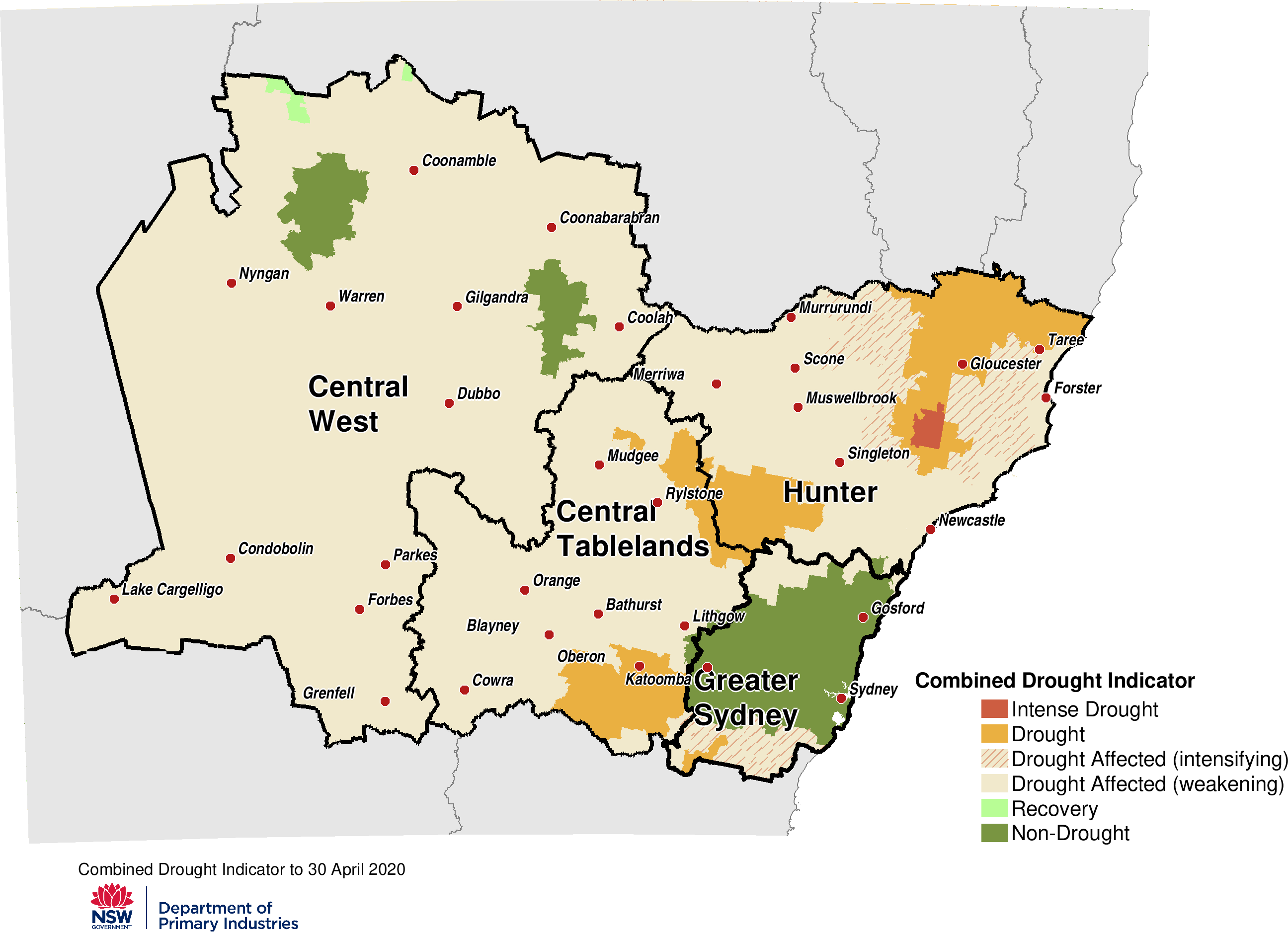
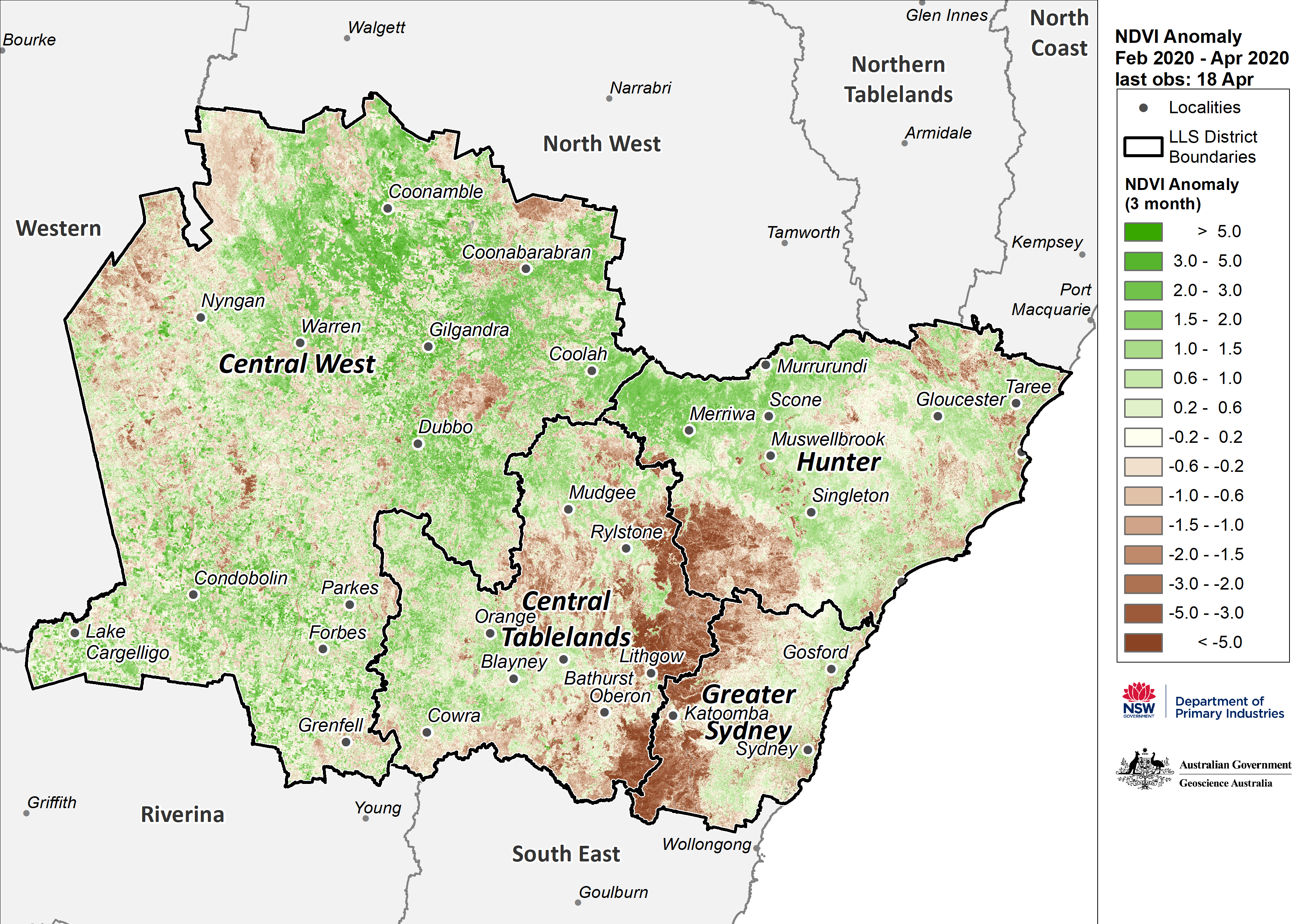
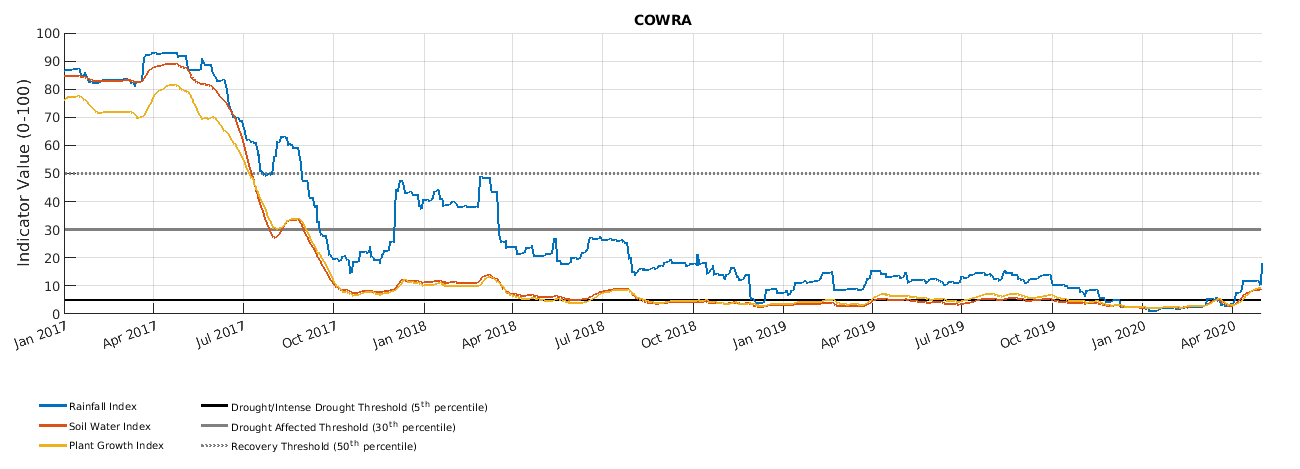
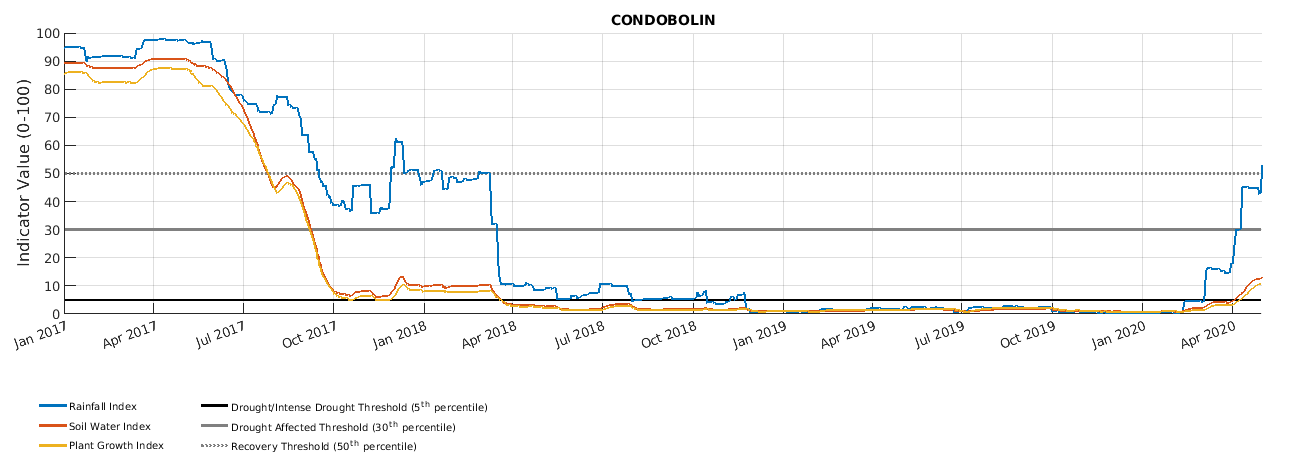
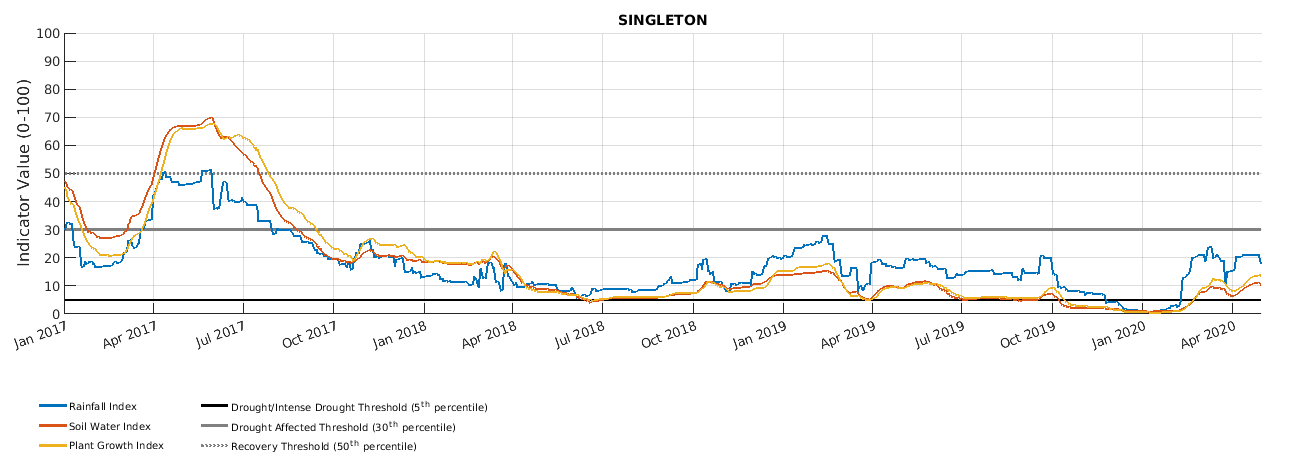
South East region
Rainfall has improved conditions in many northern areas of the South East Local Land Services (LLS) region during April, however southern areas have had little relief. The southern parts of the LLS region remain in the Intense Drought CDI category, while areas in the north has transitioned out of the Intense Drought and Drought categories (Figure 26). Follow up rainfall during winter is critical for longer-term drought recovery.
The seasonal NDVI anomaly data (Figure 27) has shown a substantial improvement since March for much of the region. The areas impacted by bushfires and where rainfall has been less effective continue to stand out. Other areas such as the north west, south west and some coastal areas are showing normal to above normal levels of plant greenness for the February to April period.
The time series charts (Figure 28) show the individual response of the drought indices at Bega, Goulburn and Cooma. They show a large degree of variability between locations. Goulburn has shown the greatest improvement of the indices during April. All locations show the importance of follow up rainfall for sustaining any improvements to the indices longer-term.
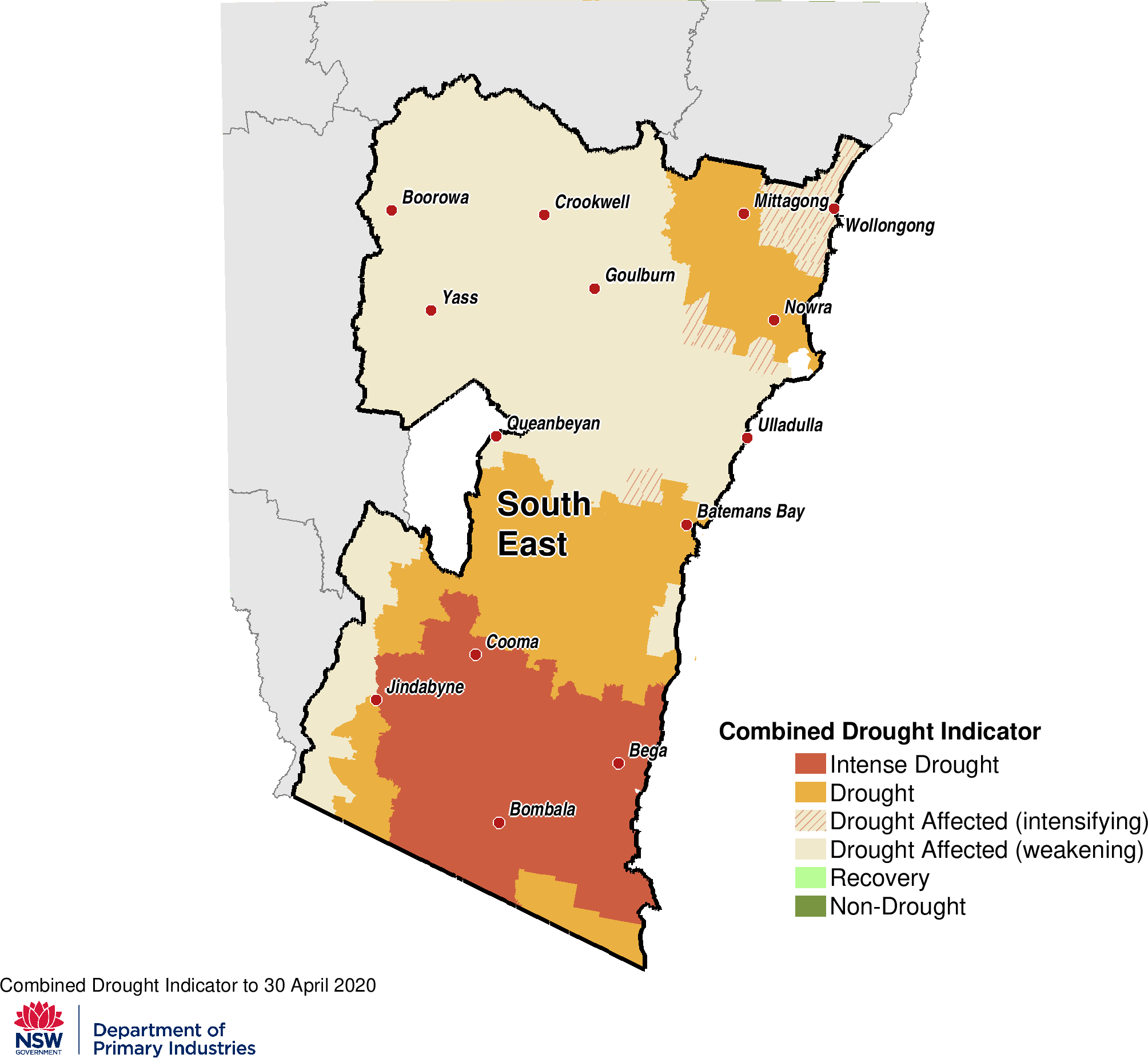
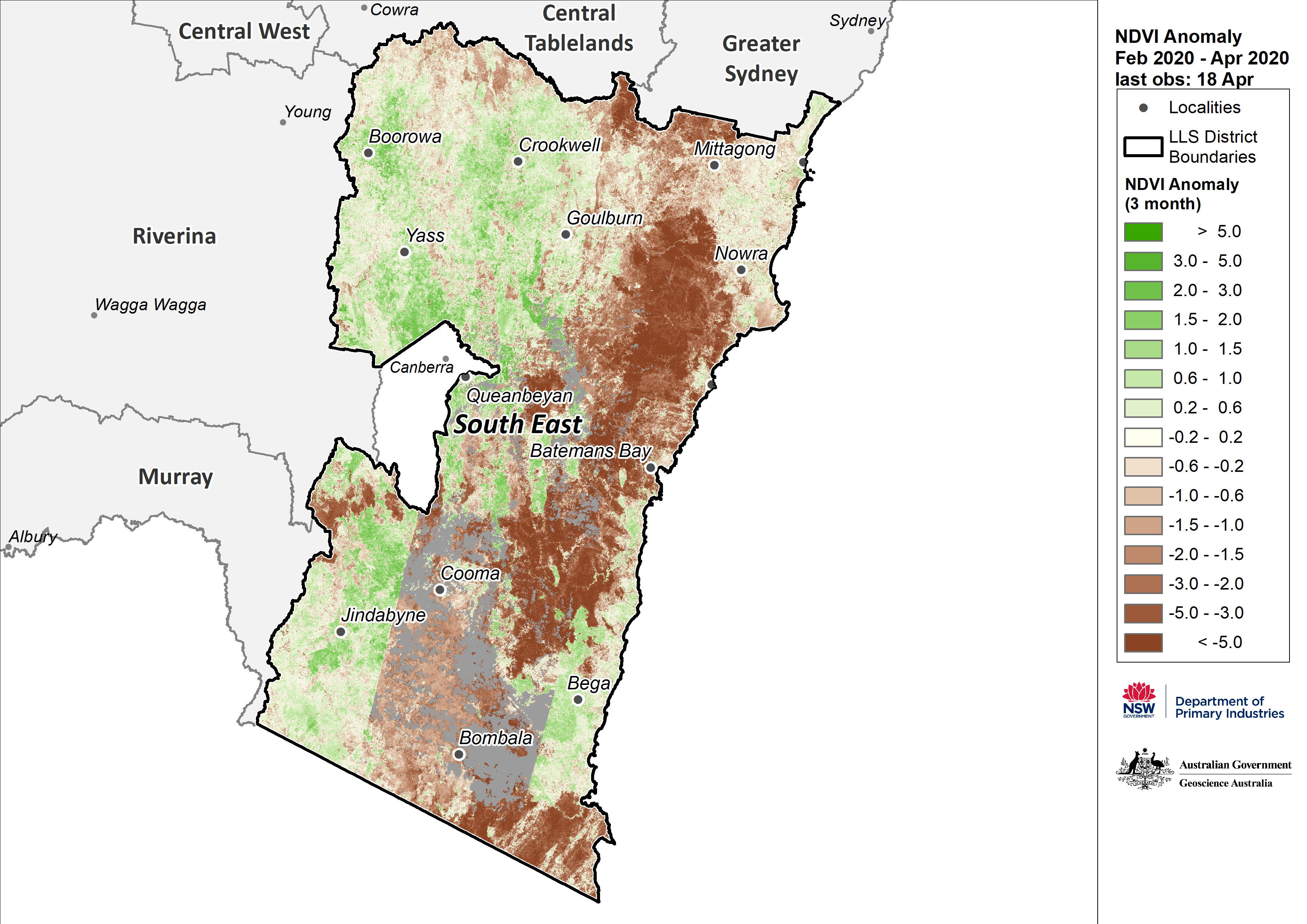
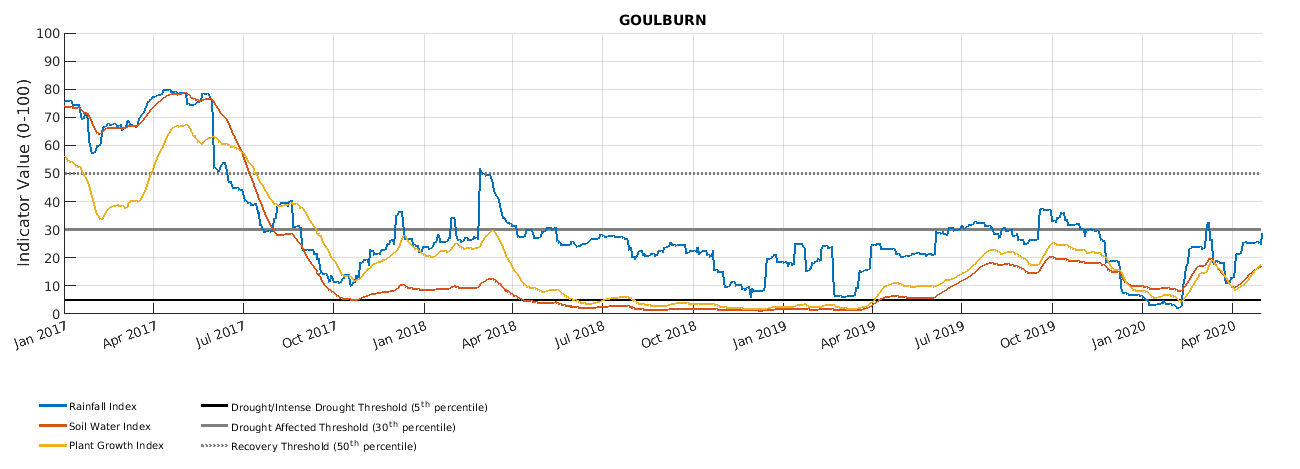
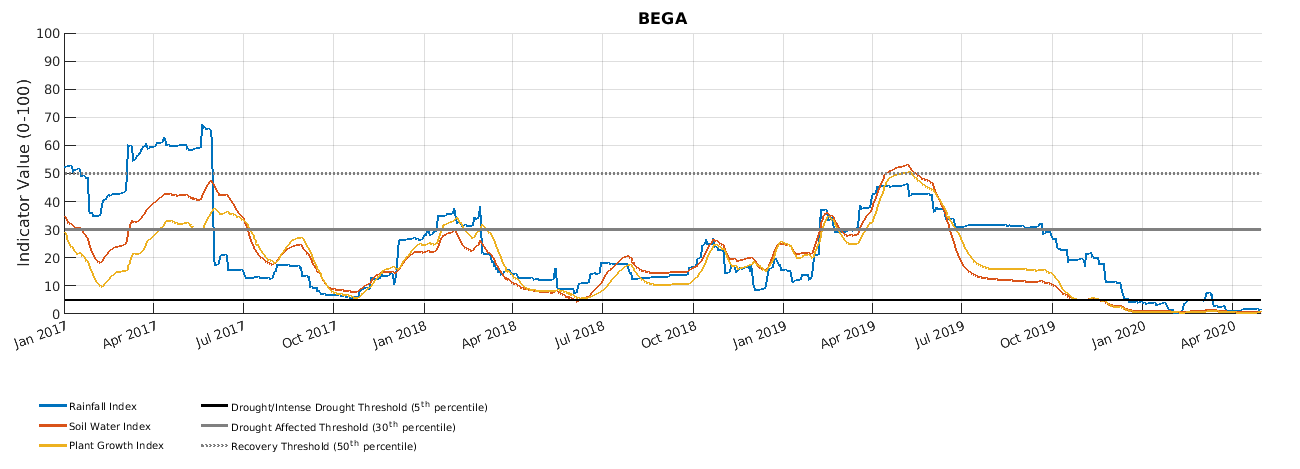

Official national outlook
The latest official national outlook was released by the BoM on 7 May 2020. The data and maps in this edition of the SSU draws from the previous release on 30 April. The signalling of conditions in the official national outlook between 30 April and 7 May is similar, though models output probabilities for above median rainfall are slightly higher.
The outlook indicates that the May to July period is more likely to be wetter than median for most of the southern two-thirds of Australia. Parts of the tropical north, and areas east of the Great Dividing Range have near equal chances of being wetter or drier than median. A warmer than average eastern Indian Ocean is currently the main influence on Australia's climate. This is increasing the moisture available to weather systems as they move across the country.
Daytime temperatures for May to July have an increased likelihood of being above median across northern, eastern and far southwest Australia, while nights are very likely to be warmer than median nationwide.
NSW outlook
There are moderate to high probabilities of rainfall being above median for areas west of the Great Dividing Range in NSW for May to July 2020. Areas east of the Divide have a near equal chance of being wetter or drier than median. (Figure 29). The historical skill for the forecast period is between 50 to 65 percent for most of NSW which is considered low to moderate.
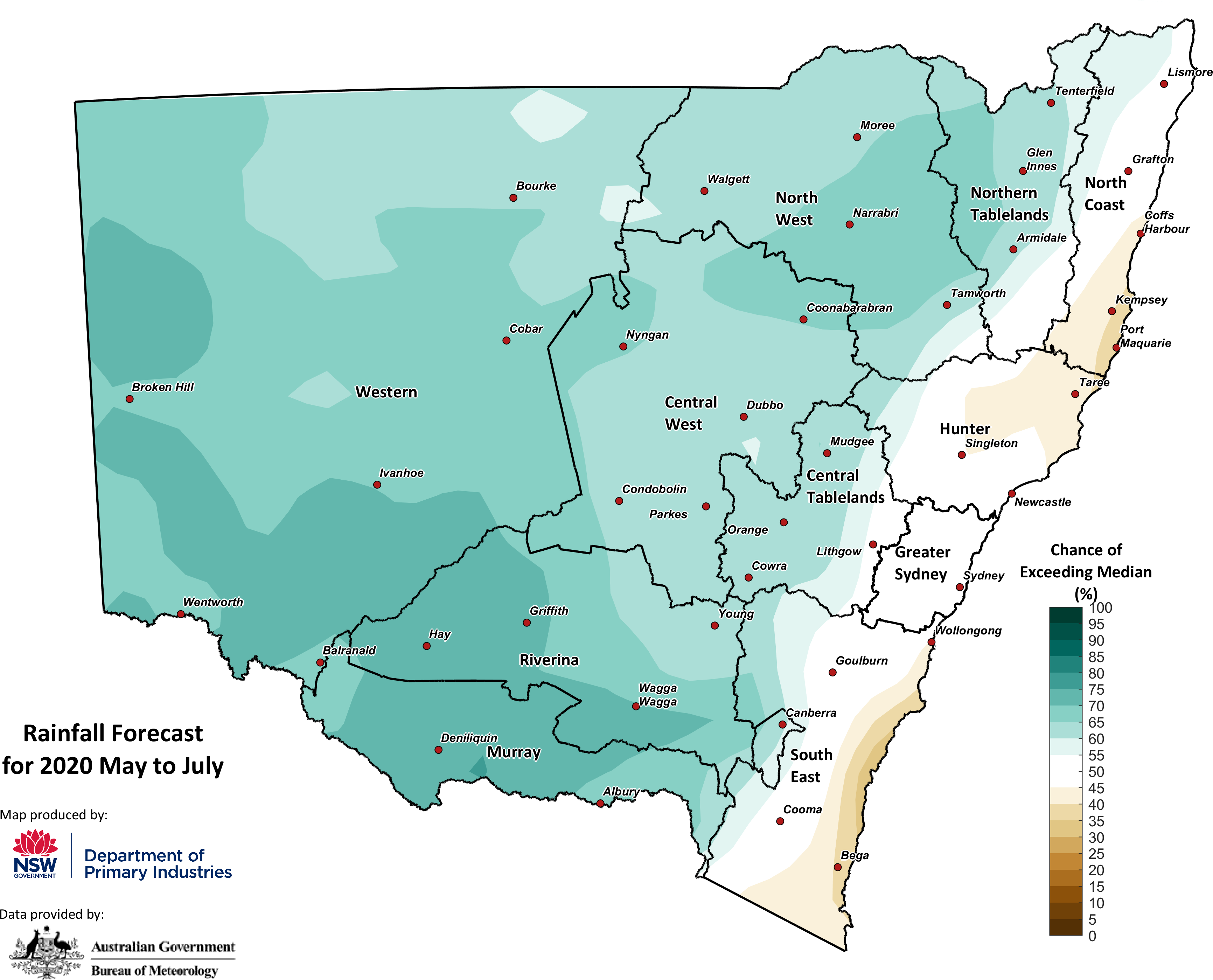
The BoM temperature outlook for May to July (Figure 30) indicates daytime temperatures have an increased likelihood of being above median for most of eastern NSW. Daytime temperatures further west have near equal chances exceeding median daytime temperatures. Overnight temperatures have a strong likelihood of being above median across NSW (Figure 31).
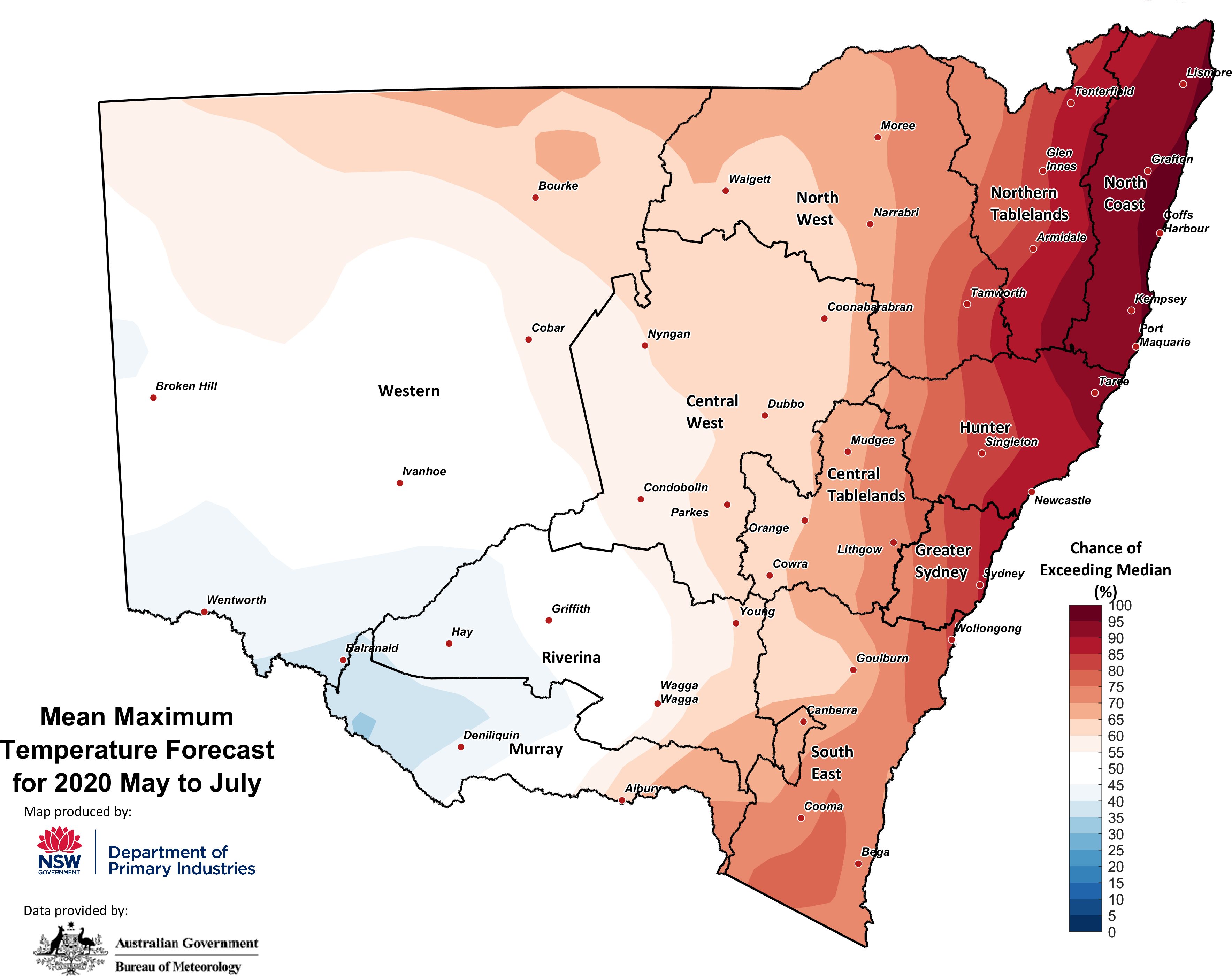
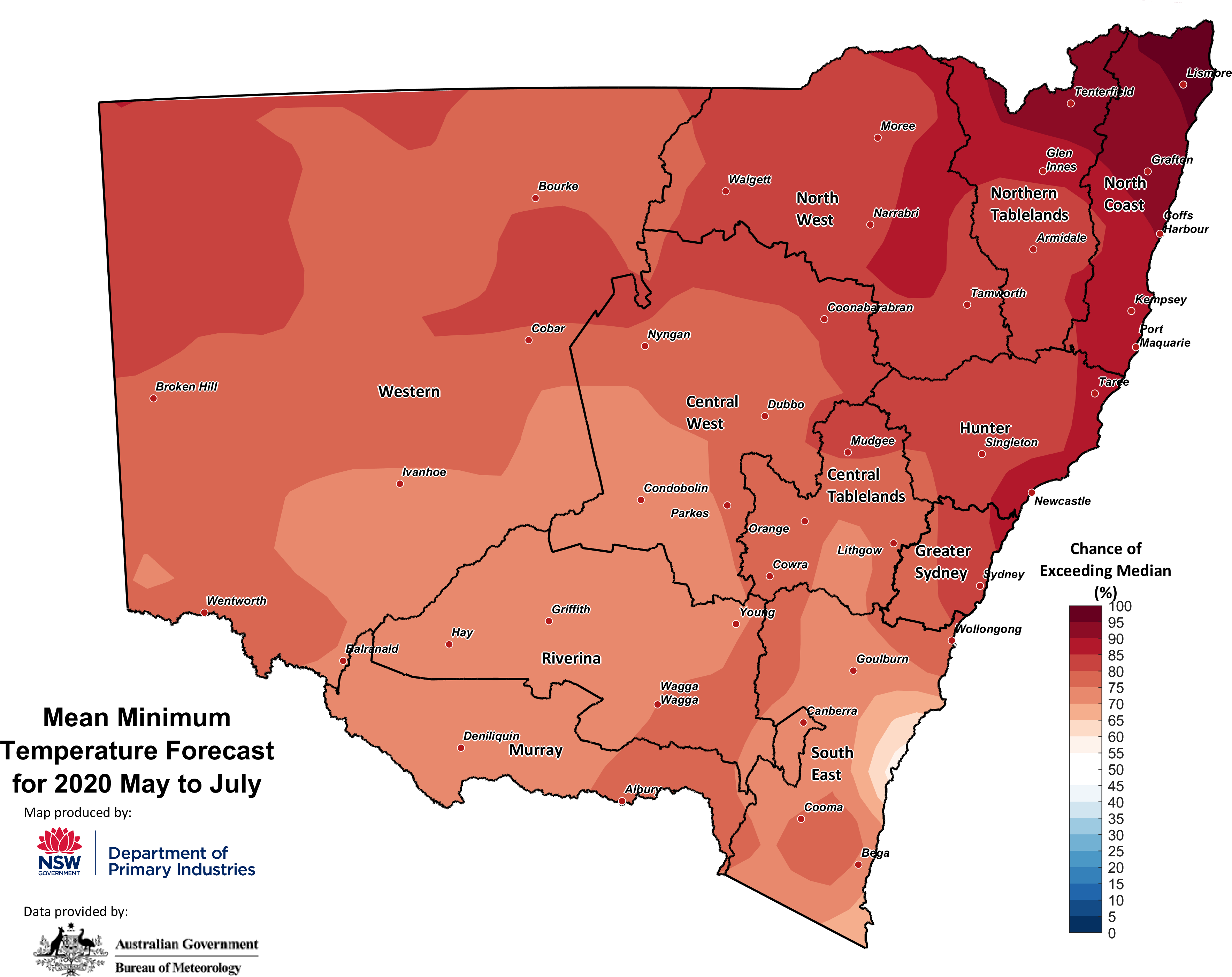
Climate drivers
El Niño–Southern Oscillation (ENSO)
The Bureau of Meteorology’s (BoM) El Niño–Southern Oscillation (ENSO) Outlook was released on 28 April 2020. All ENSO indicators in the tropical Pacific Ocean remain neutral.
Most climate models surveyed by the Bureau indicate that ENSO is likely to stay neutral through the southern hemisphere winter. By late winter/early spring, three of the eight climate models surveyed by the Bureau reach or exceed La Niña levels, while the remaining five stay neutral. ENSO predictions made during autumn have lower accuracy than predictions made at other times of the year. Therefore, the current ENSO forecasts should be used with some caution.
Atmospheric and oceanic indicators of ENSO including the Southern Oscillation Index (SOI), trade winds, cloudiness near the Date Line, and sea surface temperatures in the tropical Pacific Ocean generally persist at levels consistent with a neutral ENSO state. Sub-surface temperatures in the tropical Pacific Ocean have cooled over the past two months, indicating increased potential for cooling at the surface in the coming months under the right conditions.
Southern Oscillation Index
The 30-day Southern Oscillation Index (SOI) for the 30 days ending 26 April was −2.1. The 90-day value was −2.9. Both values are within the ENSO neutral range.
Sustained negative values of the SOI below −7 typically indicate El Niño while sustained positive values above +7 typically indicate La Niña. Values between +7 and −7 generally indicate neutral conditions.
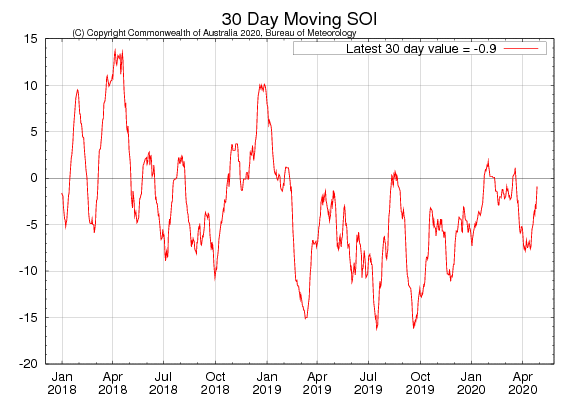
Sea surface temperatures
Sea surface temperatures (SSTs) for the week ending 26 April were warmer than average across most of the eastern half and in the far west of the equatorial Pacific Ocean, though remain within the neutral range. The eastern equatorial Pacific has warmed slightly compared to two weeks ago, while temperature anomalies in the central region have decreased slightly.
SSTs also remain warmer than average around most of Australia. SSTs are up to two degrees warmer than average around Western Australia, and up to one degree warmer than average around much of northern and eastern Australia.
The latest values of the three key NINO indices in the tropical Pacific for the week ending 26 April were: NINO3 +0.7 °C, NINO3.4 +0.5 °C and NINO4 +0.4 °C.
Persistent NINO3 or NINO3.4 values warmer than +0.8 °C are typical of El Niño, while persistent values cooler than −0.8 °C typically indicate La Niña.
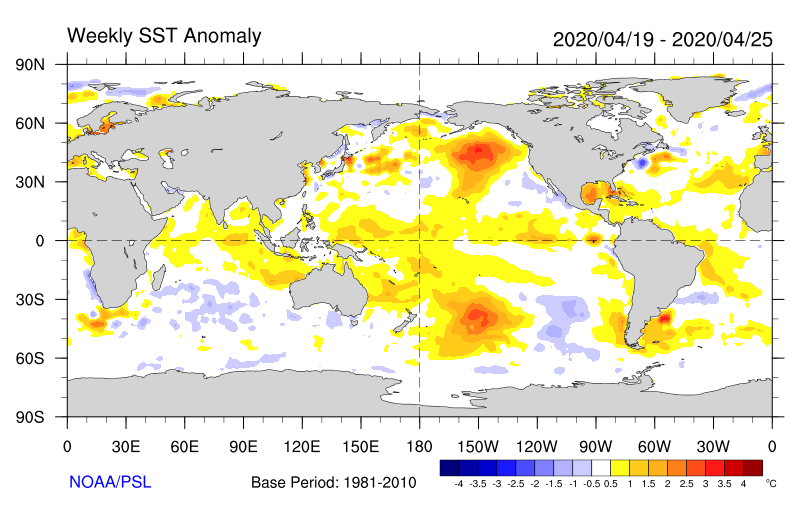
Sea sub-surface temperatures
The four-month sequence of equatorial sub-surface temperature anomalies (to 23 April) shows cooler than average waters extend in a band across most of the equatorial Pacific, between about 100 and 200 m in the western to central equatorial Pacific and rising to a depth of around 50 m at the eastern edge of the equatorial Pacific.
In the western equatorial Pacific very weak warm anomalies persist in the top 150 m, but have decreased significantly in strength and extent compared to March.
Since January, warm anomalies in the western equatorial Pacific near the surface have decreased, while the pattern of cooler anomalies at depth has strengthened.
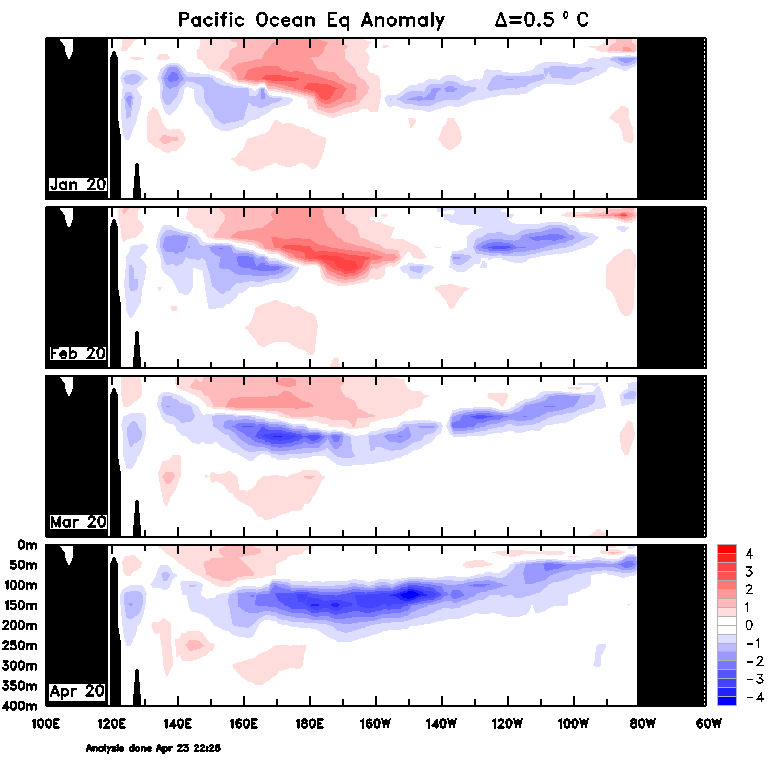
Indian Ocean
The Indian Ocean Dipole (IOD) is currently neutral. All six international climate models surveyed suggest negative IOD conditions could develop from the middle of the southern hemisphere winter.
However, the accuracy of the IOD forecast is low at this time of the year. A negative IOD typically brings above average winter–spring rainfall to southern Australia.
The IOD typically has little influence on Australian climate from December to April. As the monsoon trough retreats back towards the northern hemisphere at the end of northern Australia's wet season, we will begin to re-enter the part of the year where the IOD can form.
Southern Ocean
The Southern Annular Mode (SAM) is currently negative. It is forecast to return to neutral over the next few days and remain neutral for the coming three weeks. SAM has little influence upon Australian rainfall in autumn.
How does it work?

Much of the information in the Seasonal Conditions Report is sourced from the NSW DPI Enhanced Drought Information System (EDIS) ™. The EDIS system is currently available in prototype form and is subject to an intensive ground truthing process. For more information, visit the interactive website via DroughtHub.
EDIS is an ongoing project aimed at improving the quality and timeliness of efforts to monitor conditions across the state. Key features of the system are:
- It tracks drought by using four indicators; rainfall, soil water, plant growth, as well as tracing rainfall trends. Agronomic conditions have equal value to rainfall recorded at meteorological stations.
- The Combined Drought Indicator (CDI) brings this information together, and has been designed to characterise developing drought conditions. The key purpose for building the CDI was as a drought early warning system.
- The rainfall, soil moisture and plant growth indicators in EDIS account for conditions over a 12 month window. This provides a compromise between a highly sensitive indicator (e.g. six months) and a less sensitive indicator (e.g. 24 months).
- Climate and remote sensing data drive the information system at a high resolution, but the CDI is reported at a Parish level.
- Because of its configuration and purpose, there will be differences to the indicator used in the National Drought Monitoring Framework (the Australian Rainfall Deficiency Analyser) which relies on rainfall alone.
- The CDI has three drought categories that characterise NSW according to drought intensity as well as the main drivers of a drought event (meteorological, hydrological and agronomic). DPI considers areas Drought Affected to be experiencing a drought event.
- The Drought Affected category encompasses a wide range of conditions from the very early stages of drought entry through to a drought event becoming intense. This enables the drought monitoring system to detect a drought event early. It is also possible to stay in the Drought Affected category for some period of time.
The way in which the indicators are combined to form the CDI is described in Table 1 below.
Table 1: The way in which the indicators are combined to form the CDI.
CDI Phase | Technical definition | Description - typical field conditions |
|---|---|---|
Intense Drought | All three indicators (rainfall, soil water, plant growth) are below the 5th percentile | Ground cover is very low, soil moisture stores are exhausted and rainfall has been minimal over the past 6-12 months. |
Drought | At least one indicator is below the 5th percentile | Conditions may be very dry, or agronomic production is tight (low soil moisture or plant growth). It is possible to be in Drought when there has been some modest growth, or a few falls of rain. |
Drought Affected (intensifying) | At least one indicator is below the 30th percentile and the rainfall trend is negative over the past 90 days. | Conditions are deteriorating; production is beginning to get tighter. Ground cover may be modest, but growth is moderate to low for the time of year. When indicators are close to the Drought threshold drought conditions are severe. |
Drought Affected (weakening) | At least one indicator is below the 30th percentile and the rainfall trend is positive over the past 90 days. | Production conditions are getting tighter, but there have been some falls of rain over the past month. It is rare to enter the Recovering phase from the Non-Drought category; Usually there is a quick (1-2 week) transition into Drought Affected or Drought. When indicators are close to the Drought threshold drought conditions are severe. |
Recovering | All indicators are below the 50th percentile but above the 30th percentile | Production is occurring but would be considered ‘below average’. Full production recovery may not have occurred if this area has experienced drought conditions over the past six months. |
Non-drought | At least one indicator is above the 50th percentile. | Production is not limited by climatic conditions. |
The NSW State Seasonal Update is provided each month by the NSW DPI Climate Branch.
Information used in this report was primarily sourced from the Australian Bureau of Meteorology, the US National Oceanic and Atmospheric Administration, the International Research Institute for Climate and Society (Columbia University), Geoscience Australia’s Digital Earth Australia Program, and NSW Department of Primary Industries.
Maps in this document contain data which is © Spatial Services – NSW Department of Finance, Services and Innovation (2020), Panorama Avenue, Bathurst 2795 and data which is © Commonwealth of Australia 2020, Australian Bureau of Meteorology, Melbourne. All rights reserved.
The seasonal outlooks presented in this report are obtained from the Australian Bureau of Meteorology and other sources (including World Meteorological Organisation Global Producing Centres). These outlooks are general statements about the likelihood (chance) of (for example) exceeding the median rainfall or minimum or maximum temperatures. Such probability outlooks should not be used as categorical or definitive forecasts, but should be regarded as tools to assist in risk management and decision making. Changes in seasonal outlooks may have occurred since this report was released.
All climate and remote sensing input data is supplied to the Enhanced Drought Information System ™ under the Australian Creative Commons Licence (CCY 4.0) and is made available by the Terrestrial Ecosystem Research Network.
© State of New South Wales through the Department of Industry, Skills and Regional Development, 2020. You may copy, distribute and otherwise freely deal with this publication for any purpose, provided that you attribute the NSW Department of Primary Industries as the owner.
Disclaimer: The information contained in this publication is based on knowledge and understanding at the time of writing (January 2020). However, because of advances in knowledge, users are reminded of the need to ensure that information upon which they rely is up to date and to check currency of the information with the appropriate officer of the Department of Primary Industries or the user’s independent adviser.
Published by the NSW Department of Primary Industries. ISSN 2202-1795 (Online). Volume 8 Issue 4.

